

Mark Your Calendars







By Sadeen Mohsen
The Glebe Parents’ Day Care (GPDC) will be entering an amalgamation with Andrew Fleck Children’s Services in the upcoming months, a move that’s facing some backlash in the community.
The day care originally began as a grassroots initiative in the 1970s with deep community ties and is described as “a non-profit, charitable organization that functions as a parent-staff cooperative.” GPDC now has four day cares, on Fifth at the Canal, on First Avenue, at Mutchmor and at Hopewell.
The board’s decision to merge with Andrew Fleck, a long-running registered charity that operates more than a dozen day cares and nursery schools in the Ottawa area, comes after months of deliberation and “heavy discussion.” The day care has faced several challenges including governance, financial difficulty and programming problems.
It has been classed as tier-three licence since August 2022, the lowest level for a day care facility, and has been at risk of licence suspension by the Ministry of Education.
Patrick Saunders-Hastings, chair of the GPDC board, remains optimistic that the amalgamation, which has been considered several times over the past decade, will bring positive changes to the day care.
“[Andrew Fleck] has a really strong track record of success and we’re really quite excited to preserve and maintain the Glebe day care sites for community members,” he said.
keeping the community connection.
“We are quite keen on the administrative support that an organization like Andrew Fleck will be able to provide, to enable us to bring an improved program quality, stability and viability while preserving that sense of community for parents, staff and children.”
Saunders-Hastings says that parents can expect things to “stay the same,” including fees, classrooms and teachers. He says they are also expecting increased city funding which would go to improving the day care.
Staff members can expect “stability and support,” professional development and administrative support from Andrew Fleck. According to Saunders-Hastings, staff are being offered positions at their current sites.
He insists many parents have expressed positive support but concedes others have indicated concern and hesitation about the move.
“Emotions run high when we’re talking about employment or childcare, and we’re talking about both,” Saunders-Hastings said. “I think we’re in a period of a bit of uncertainty where we’re doing our best to communicate as much as possible.”
Despite his optimism, members of the community, including day care staff, are showing some resistance. A petition to “save the community-based childcare centre” had garnered more than 1,340 signatures at this writing.
disappointment with the board for failing to include them in the decision to merge. “You trust us with your children every day, in turn we trusted you to operate in good faith, openness and transparency,” one letter reads. “To say I feel blindsided is an understatement.”
Another letter from a staff member who has been with GPDC for over 30 years says they feel “undervalued and dismissed” due to a lack of transparency between the board and the staff. “The idea that a long-standing, community-based childcare centre that was built on the backs of committed parents, community members and staff would so easily be amalgamated, without community consultation, is unbelievable,” the letter reads.
Many GPDC parents didn’t know much about the upcoming amalgamation. For Florence Chiwocha, it came as a big surprise. “It was kind of sudden,” Chiwocha said. “I came in one morning and everybody’s dressed in black.” She was told this was to convey staff discontent with the board’s decision.
Chiwocha’s daughter has been attending the day care for more than two years. The board’s decision to amalgamate has left her worried about her daughter’s experience at the day care, and she’s uncertain whether to keep her there.
NEXT ISSUE: Friday, September 13, 2024
EDITORIAL DEADLINE: Monday, August 26, 2024
ADVERTISING ARTWORK DEADLINE*: Wednesday, August 28, 2024
*Book ads well in advance to ensure space availability.
Saunders-Hastings spoke highly of the support and new funding that Andrew Fleck would bring to the GPDC to bring “new life” to its programming while
“We believe that this decision is too large to be made by 8 people when there are hundreds of stakeholders that will be affected by this change,” the petition reads.
The petition also contains two anonymous letters from long-term staff members, expressing their
“When I bring my daughter here, I want it to be a place where she’s happy,” she said. “If staff members aren’t happy, that’s going to affect her. At the end of the day, it’s going to affect the quality of care my daughter receives. I think the [staff members] deserve better. Looking after toddlers is not easy.”
Sadeen Mohsen is a journalism student at Carleton University.






By Erin Gilmer and Piaf des Rosiers
This year marks the anniversary of the opening of the First Avenue Daycare, a satellite program of the Glebe Parents’ Day Care.
The site was opened to meet the needs of families within the Glebe and at the First Avenue Public School. The program has been a huge success from day one and has earned a glowing reputation within the Glebe and surrounding areas.
The beautiful, purpose-built space that the program operates in today was an initiative spearheaded by the staffing team, along with incredible support from former Glebe Parents’ Day Care parent and staff board members, community partners and stakeholders, the Ottawa-Carleton District School Board, Best Start funding, the Ministry of Education and the community at large. Special thanks go to Dave Hagerman, whose knowledge, passion and leadership in the childcare sector will not be forgotten.
The educators at First Avenue have passionately and lovingly created a community-based program
that fosters learning, caring, kindness and cooperation. Their reputation has made them and the site a fixture in our community for the past two decades.
The First Avenue program staff credit their success to the relationships that they have been able to build with their families in this little gem of a centre. “Our cooperative philosophy shapes the work we do,” says Athina Basiliadis, a beloved First Avenue team member who has been there since the beginning. “Relationships are built with families in a way that ensures a respectful partnership is at the core of what we all do together. It’s a relationship built on trust and commitment to the greater good, and the rewards are plentiful.”
Although the childcare sector in the City of Ottawa and across Ontario is struggling with recruitment and retention issues, this team of six staff at First Avenue has stayed the course. They cite the small size of their program, the respect, support and appreciation that their families have shown them over the years and the value that parents and the community place on the work they do as the reasons why they still love coming to work each day.
The educators at First Avenue hope to continue to offer community-based, cooperative childcare at their site for years to come. Parents and community stakeholders are working hard to ensure the program continues to flourish and retain its roots amidst the pending structural change at the Glebe Parents Day Care (see elsewhere in this issue). Past families, current families and future families will benefit from the continuity of passionate educators which directly impacts the quality of care being provided. Parents deserve options for care that meet their needs and their expectations. It should not be a “one size fits all approach” to childcare.
The First Avenue community is planning an anniversary celebration for First Avenue families, past and present, in the near future. Please email us at firstavenuecelebration@gmail.com to add your name to the guest list and lend your voice to securing our program and dedicated team for years to come.
Erin Gilmer and Piaf des Rosiers are local residents and proud First Avenue day care parents.


By David Stewart
In 1965, long-time Glebe resident David Stewart travelled from Michigan State University to Mississippi’s Rust College in support of the civil rights movement in 1960s America. In this U.S. election year, he returned to the College and learned what has changed and what has not.
This past January as we watched an old movie, Mississippi Burning, I told my wife Debby that the film brought back memories of the summer of 1965, when I taught science study skills to incoming freshmen at Rust College.
Located in the northern hill country of Mississippi, this small, historically black college sits overlooking Holly Springs, an old plantation town of 6,000 residents of whom 83 per cent are black. The College was founded by the Freedman’s Aid Society of the Methodist Church in 1866, immediately after the Civil War. Vice-President Kamala Harris, now running for president, is a graduate of a much larger historically black institution, Howard University in Washington, D.C..
I had for some time dreamed of going back to Holly Springs. Debby and I travelled there in May, a journey to celebrate my 80th birthday by revisiting my youthful experience. We also hoped to connect with people at today’s Rust College.
In the cause of civil rights
The story begins a few months earlier at Michigan State University (MSU) where I was a pre-med student and an editor of The State News, a daily student newspaper with a press run of

37,000 copies. It was a crucial time for the U.S. civil rights movement and our paper covered it heavily.
The Civil Rights Act of 1964 outlawed segregation and racial discrimination, but its enactment, of course, did not end either. So, in winter 1965, I helped organize a group of two dozen students aiming to contribute our help to the cause. We connected with Rust College which then had an enrolment of about 1,000 students. Our project was the first student-administered education outreach of its kind in the country.
As part of our effort, we invited Martin Luther King, Jr. to speak at MSU. On February 11, 1965, the university auditorium was filled. We charged admission of $1 and raised over $4,000 for our project. Dr. King spoke for an hour, speaking in a measured and deliberate manner at first, gradually increasing his cadence, then concluding with great passion and drama to resounding applause. He said, “We must learn to live together as brothers, or we will perish as fools.” And, “It may be that morality cannot be legislated, but behaviour can be regulated.”
Six months later President Lyndon Johnson signed the Voting Rights Act, allowing black people for the first time to vote in the South in significant

We must learn to live together as brothers, or we will perish as fools.
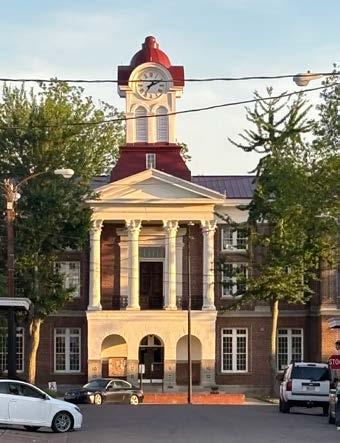
numbers. It ended what Dr. King called the “complicated and absurd” literacy tests required for voter registration.
Martin Luther King, Jr. was assassinated on April 4, 1968, in Memphis, a mere 55 miles north of Holly Springs.
The struggle continues
In the 59 years since my initial visit, Holly Springs has changed. A new interstate sweeps around the town. As in many small Ontario towns, the downtown seemed ghostly quiet. Holly Springs could fairly be described as a poor town in the poorest state in America. Still, while it’s different on the surface, whites still live in the nicest antebellum homes, some very grand. Blacks tend to have the menial jobs. A white shop clerk to whom I mentioned the Civil War corrected me, calling it “the War of Northern Aggression.” The town can also be violent. A man was shot and killed in the poor north end a day before we arrived.
But now I could wander about at random. Back in 1965, any walk into the town meant going with a buddy and alerting others to our trip. I was warned not to stand in front of a window at night unless the curtain was pulled shut. Black students told me they had no use for Elvis Presley who was born nearby in Tupelo: “He never liked us black folks.” William Faulkner, who grew up and spent much of his life in nearby Oxford, Mississippi, was seen to drive his jeep wildly in the town and,

I was told, “He was not at all sociable, and maybe drunk.”
Dr. Robert Dixon, Rust College’s interim president, met with Debby and me for a good long chat about social change and civil rights. He recalled his own experience of registering to vote in Atlanta in the 1960s. He was asked to interpret passages in the Georgia Constitution. Later, at a Class of 1964 luncheon, we heard individual accounts of the struggle of black groups to advance themselves and to achieve full civil rights. Finally, we were invited to be Dr. Dixon’s guests on the stage for the Class of 2024 graduation ceremony. It was a true honour to be part of this group dedicated to the cause championed by Dr. King and so many others, before and since.
Before leaving Rust College, I donated to their library collection eight original 19th-century newspapers printed in the American South. They contain advertisements of slave auctions and rewards for the capture of runaway slaves and of black soldiers serving in the Union Army during the Civil War.
It’s different today. But Dr. King’s quest for equality, unequivocal and universal, continues.
David Stewart is a long-time Glebe resident and medical doctor who is passionate about social justice and its history. He also collects original vintage newspapers, pre-1870.

Jide Afolabi, Jennie Aliman, Lawrence Ambler, Nico Arabackyj, Aubry family, Miko Bartosik, Alessandra & Stefania Bartucci, Selena Beattie, Adrian Becklumb, Beckman family, Joanne Benoit, Inez Berg, Carolyn Best, Carrie Bolton, Daisy & Nettie Bonsall, Martha Bowers, Bowie family, Adélaïde and Éléonore Bridgett, Bob Brocklebank, Naomi and Audrey Cabassu, Ben Campbell-Rosser, Nico Cauchi, Bill Congdon, Ava & Olivia Carpenter, ChiuPanczyk Family, Sarah Chown, Sebastian, Cameron & Anna Cino, Janis Ellis-Claypool, JJ Comptois, June Creelman, Marni Crossley, Olivia Dance, Mark Dance, Dawson family, Richard DesRochers, Davies Family, Nathan and Roslyn Demarsh, Marilyn Deschamps, Diekmeyer-Bastianon family, Dingle family, Delia Elkin, Nicholas, Reuben, Dave & Sandra Elgersma, Patrick Farley, James & Oliver Frank, Judy Field, Federico Family, Maria Fobes, Liane Gallop, Joann Garbig, Joyce Goodhand, Camilo Velez Gorman, Barbara Greenwood, Marjolein Groenevelt, Oliver, Martin, Sarah & Simon Hicks, Cheryle Hothersall, Jennifer Humphries, Sandiso Johnston, Jungclaus Family, Elena Kastritsa, Kasper Raji Kermany, Michael Khare, Lambert family, Fenton & Cora Hui Litster, Leith and Lulu Lambert, Kathleen Larocque, Catherine Lawr, Mel LeBlanc, Jamie, Alexander & Louisa Lem, Brams and Jane Leswick, Alison Lobsinger, Aanika, Jaiden and Vinay Lodha, Hudson Love, Andy Lunney, Vanessa Lyon, Pat Marshall, Patrick Collins Mayer, Catherine McArthur, Ian McKercher, John and Helen Marsland, Matthew McLinton, Josephine & Elise Meloche, Cameron Mitchell, Julie Monaghan, Thomas Morris, Vivian Moulds, Karen Mount, Maddy North, Diane Munier, Xavier and Heath Nuss, Sachiko Okuda, Matteo and Adriano Padoin-Castillo, Brenda Perras, Brenda Quinlan, Annabel and Joseph Quon, Beatrice Raffoul, Bruce Rayfuse, Kate Reekie, Thomas Reevely, Mary & Steve Reid, Jacqueline Reilly-King, Anna Roper, Sabine Rudin-Brown, Frank Schreiner, Short family, Cathy Simons, Andrew Soares, Stephenson family, Cameron & Quinn Swords, Ruth Swyers, Saul Taler, John & Maggie Thomson, Tom Trottier, Trudeau family, Will, Georgie & Blaire Turner, Zosia Vanderveen, Veevers family, Nick Walker, Vanessa Wen, Paul Wernick, Hope, Jax and Ash Wilson, Howard & Elizabeth Wong, Ella & Ethan Wood, Berkan Yazici, Martin Zak.
THANKS AND FAREWELL:
Lambert Family
Adrian and Juliet Becklumb (17 years!)
CARRIERS NEEDED FOR:
NE5 - O’Connor: Pretoria to First Ave
WELCOME TO:
AREA CAPTAIN: Julie Stephens

If you are not receiving your Glebe Report at home, please notify our Distribution Manager at circulation@glebereport.ca.

What are the dog days of summer?
Don’t worry, I looked it up for you.
They’re the hot, sultry days of full-on summer – I think of late August in Ottawa, with memories of hanging out the window of an airless and stifling third-floor bedroom in the days before air conditioning, hoping for even the slightest waft of breeze.
Literally, the term dog days refers to the time near the end of July, the hottest days of the year, when the constellation Sirius, the “dog star,” appears in the sky just before the sun. Romans referred to this time as “dies caniculares” or days of the dog star. The Greeks connected the dog days with heat, drought, thunderstorms, lethargy, fever, mad dogs and bad luck. Ancient Egyptians used it as a watchdog for the timing of the annual flooding of the Nile.
Metaphorically, dog days often mean a period of stagnation, when nothing
much happens and no one much cares – a drowsy time of lethargy and little drive. A lazy hot day on the beach under a blistering sun. A somnolent Friday afternoon at the office with most of your colleagues gone somewhere, who knows where?
The word “dog” itself, other than referring to cuddly canines, can conjure up bleak times when you’re dogged by worries and labours that you feel you must doggedly pursue. You may feel that you’re working like a dog, in this dog-eat-dog world. Indeed, life itself may have gone to the dogs. Dare I mention the dogs of war that may be about to be unleashed on the world?
Well, buck up and take courage – the havoc of back-to-school chaos is about to descend upon us. Should we be careful what we wish for?
—Liz McKeen
Established in 1973, the Glebe Report, published by the Glebe
EDITOR............................ Liz McKeen editor@glebereport.ca
COPY EDITOR.................... Roger Smith
LAYOUT DESIGNER............. Jock Smith layout@glebereport.ca
GRAPEVINE EDITOR............ Micheline Boyle grapevine@glebereport.ca
WEBSITE EDITOR/SOCIAL MEDIA.. Kayleigh Osborne website@glebereport.ca
ADVERTISING MANAGER...... Judy Field advertising@glebereport.ca 613-858-4804
BOOKKEEPER.................... Susanne Ledbetter accounting@glebereport.ca
DISTRIBUTION MANAGER.....
COMMERCIAL DISTRIBUTORS Murray Kronick circulation@glebereport.ca Teddy Cormier, Eleanor Crowder
PROOFREADERS................ Martha Bowers, Jennifer D'Costa
AREA CAPTAINS................. Martha Bowers, Bob Brocklebank, Judy Field, Deb Hogan & Dave Yurach, Lynn & Dave Johnston, Elena Kastritsa, Brenda Perras, Julie Stephens, Della Wilkinson
Witch Chest is now open at 740 Bank Street. “Ottawa’s Safe Space for Witches. Where imagination meets intention and dreams become reality.” Julie is a “long-practising Celtic hearth witch.” Free local delivery.
Third Son Tailor is now open at 796 Bank Street. “Ottawa’s bespoke tailor shop . . . Semi-bespoke, madeto-measure, ready-to-wear, alterations.” Custom, weddings, alterations, interiors (upholstery). 613-234-8484. glebe@3rdson.ca.
Happy Days burgers & poutine is now open at 200 Marché Way in Lansdowne.
Porsche NOW pop-up location is now open at 225 Marché Way in Lansdowne. Operated by Mark Motors Porsche. “This setting allows visitors to engage with the Porsche brand, explore the vehicles, and consult with product experts in a welcoming, low-pressure atmosphere.”
ALL ECO bricks-and-mortar store at 857B Banks St. is now closed as of July 28, but continues online. Glebe BIA: “We’re saying goodbye to ALL ECO’s beloved Glebe location as they transition to online-only sales.” alleco.ca
Lois ‘N’ Frima’s Ice Cream and Heads Up Barber Shop at 837 Bank Street have closed, after a little more than a year in business.
Drip House coffee shop now open at 843 Bank, corner of Fifth and Bank, with patio.
Iva Apostolova
Dianne Breton
Maria Calderisi
Sylvie Chartrand
Terry Cheney
June Coxon
John Crump
John Dance
Nadine Dawson
Oscar Dennis
Piaf des Rosiers
Eileen Durand
Mary Forster
Eric Gilmer
Marjolein Groenevelt
Joel Harden
Jennifer Humphries
Bob Irvine
Nili Kaplan-Myrth
Faye Kert
Carolyn Mackenzie
Alexa MacKie
Janice Manchee
Suzanne McCarthy
Shawn Menard
CONTACT US 175 Third Avenue Ottawa, Ontario K1S 2K2 613-236-4955 D@glebereport
SUBMIT ARTICLES editor@glebereport ca
OUR DEADLINES
Sadeen Mohsen
Yasir Naqvi
Michael Kofi Ngongi
Tim O’Connor
Kevan Pipe
Louise Rachlis
Kate Reekie
Sue Reive
Marisa Romano
Sarah Routliffe
Katherine Slack
Dorothy Speak
Sue Stefko
David Stewart
Debbie Stewart
Andrea Tomkins
Claire Trépanier
Justin Van Leeuwen
Carol Warburton
Charles Weiner
Della Wilkinson
Cecile Wilson
Jillian Wright
Zeus
For Glebe Report advertising deadlines and rates, call the advertising manager Advertising rates are for electronic material supplied in PDF format with fonts embedded in the file
Editor, Glebe Report
Re: “Glebe Apothecary has closed permanently,” Glebe Report, June 2024.
Your coverage of the Glebe Apothecary’s permanent closing following the fire in March in the June Glebe Report and the continued plight of The Papery after more than two years are a sad reminder of our loss and the potential long-term change of our “main street.” Yes, it is good to know that Shoppers at 702 Bank has absorbed all the staff from Apothecary, and that it is still within the neighbourhood (sort of). But it has a completely different look and atmosphere, and a line of health supplements that I have been faithful to for many years is absent from their shelves.
What will become of the unique street front at the old place? I am hoping that the owners will have intelligent or even delightful plans for its future.
In the meantime, we must remember to be grateful for the remaining merchants in this corner of the Glebe, such as Glebetrotters, Whole Health Pharmacy, Glebe Meat Market, the Wild Oat, Von’s, Glebe Tailor, Capital Home Hardware, J.D. Adam, Il Negozio Nicastro, to name a few, and of course not forgetting our dear local supermarket, Glebe Metro! Let us continue to support them, lest they too succumb to the stress of changing markets and real estate values, not to mention other disasters!
Maria Calderisi
Editor, Glebe Report
Re: ‘Hollowing out Glebe?’ Editorial, Glebe Report, June 2024
The Papery would like to clarify that we are still planning to reoccupy our old space at the corner of Bank and Fifth, which was closed due to a fire in December 2022.
There has been considerable work done on the property. Repairs to the two floors of apartments were prioritized, and tenants have returned to their homes there. The landlord’s work in our space is nearly complete, and we have begun construction of our new fixtures. The editor’s comments cast doubt on our return, and that is completely contrary to our aspirations!
Katherine Slack Owner, The Papery
Editor, Glebe Report
This June, residents of Ella and Ralph Streets were given an opportunity to discuss a city plan to “renew” their streets by reconstructing sewer and watermains and making a number of other “improvements.” While infrastructure renewal is always a good idea, what is neither necessary nor cost-effective, let alone worth doing, is the proposed reconstruction of the sidewalks, curbs and street width on Ralph.
Having been born in the Glebe, grown up on Fourth Avenue, attended Corpus Christi and owned a house on the corner of Fifth and Ralph for the last 41 years, I can assure you that last thing the traffic on Ralph Street needs is calming. There is no traffic. Ralph is a quiet side street off Fifth Avenue that curves gently from Mutchmor School to Brown’s Inlet and the Canal. Its chief use is parking for occasional events at Lansdowne Park or for local shoppers – none of those people drive beyond a crawl since they are desperately looking for somewhere to park. The odd frog or turtle crossing at Brown’s Inlet in the spring offers a natural, no-cost, albeit seasonal, traffic-calming influence.
In what parallel universe has anyone ever asked that their street be narrowed and their sidewalk enlarged? For 41 years, I have seen very few people walk along Ralph Street and never heard anyone wish for wider sidewalks. Amazingly, entire neighbourhoods, such as Westboro and Rockcliffe Village, have survived for years without sidewalks on many of their streets.
While drivers often fail to obey the stop signs at Fifth Avenue in front of the school, I have rarely seen anyone fail to stop before turning left or right at the Ralph Street sign. During the school season, a crossing guard has outperformed any speed bump in protecting children and their families crossing the road. Not only are live people far more effective than a bump-out, they also do not interfere with the intermittent ploughing of Ralph Street during winter.
While Ralph Street is effectively safe from road maintenance summer or winter, in the four decades I have used my laneway, I have observed that neither road nor sidewalk snow ploughs pay much attention to the street from November to March either. Narrowing the street would simply make driving and walking more hazardous as the snow piled up on both sides of the street and bump-outs and wider sidewalks would create an icy tunnel for elderly, handicapped or pram-pushing sidewalk users to negotiate. Snowbanks piled up at every extension would render it more difficult to see small children trying to get to school, thereby creating an even more dangerous situation than whatever traffic reduction they are supposed to achieve.
By all means, fix the sewers and repave Ralph Street, but stop wasting taxpayer dollars on an unwanted, ill-advised plan for widening/narrowing/slowing non-existent traffic.
Faye M. Kert, Ph.D.

Editor, Glebe Report
The more I read about the tourism crisis in Venice, Barcelona and other cities, the more I am convinced that the Glebe too is suffering from over-tourism. Historically, the Glebe has been caught in the middle of long-standing events such as the Tulip Festival, Winterlude, the National Capital Marathon. Now, added to this, are endless attractions at Lansdowne: myriad festivals, the Christmas Market, 67s and RedBlacks games, concerts, the volume of which leave houses two kilometres away shaking, as well as a large number of big-box drinking establishments.
The Glebe has become the parking lot for all these events. We have bumper-to-bumper parking on our streets, high fuel emissions, cars blocking our driveways, people urinating in our driveways and throwing empty beer cans on our properties, attendees returning to their cars after dark, rowdy and often inebriated and driving home in this condition, while police turn a blind eye. The claim that ticket holders would leave their cars at Brewer Park or Carleton and shuttle to Lansdowne was always a fiction. The City and OSEG knew this. They even put up signs telling people how far to Lansdowne if they park on our streets.
Now, we have StrongTownsOttawa advocating for the elimination of parking on Bank Street, which would drive yet more people to park on residential streets. Who are these people? We don’t in fact know. It seems that if you give yourself a name, slap a few clichés on your website and hold a demonstration, you must be accommodated.
This group claims that the sidewalks on Bank Street are too narrow, causing people to bump into each other. Nonsense. I’ve lived in the Glebe for 40 years, and I’ve never bumped into another pedestrian. Another of their suggestions is permanent bike lanes. Did we not just spend millions creating bike lanes on O’Connor, only a block east of Bank, running from Parliament Hill to Lansdowne? What’s wrong with using that? And what about the multi-use pathway beside the Canal, which also accesses Lansdowne?
I don’t see Venice and Barcelona altering their cities to accommodate the ever-swelling river of tourists. No. They are instead taking measures to curb tourism, to preserve their quality of life and their rights as citizens. We in the Glebe are paying high property taxes for a disappearing way of life. The Glebe is a residential area, a community, not a tourist facility. We live here. This is our home. Tourists are just passing through. When are Glebites going to stand up and reclaim their neighbourhood?
Dorothy Speak
Re: “The Folly of parking fines geared to income,” Letter to the Editor, Glebe Report, June 2024
Just read the letter in the Glebe Report on this. Obviously, there are some really deep philosophical differences on the role of socioeconomic policies. The question here is whether to treat people the same or treat them equally. Treating everyone the same is a difference of fact; treating them equally creates a different impact. The parking fine is not an attempt at income redistribution. The parking fine is intended to be a deterrent. The same fine has a different deterrent impact if it is identical for everybody. Richer people may not care, eliminating the deterrent effect. So scaled fees are actually fair fees. (The same applies to speeding fines.)
Terry Cheney
Editor, Glebe Report
Re: “Tulip Festival a circus of commerce and junk food,” Letter to the Editor, Glebe Report, June 2024
This letter by Dorothy Speak in the June Glebe Report really touched me because I share her feeling. The attraction of the Tulip Festival has always been the experience of strolling quietly amongst the flower beds, taking pictures, admiring the large green lawns and, for some of us, reflecting on nature’s beauty in a relatively silent environment.
Traditionally, Commissioner’s Park has been an oasis of peace for people who wanted to escape the noise, traffic and ugliness of commercial advertisements typical of bustling cities. I do not know who grants licences to businesses allowing them to set up their activities in the park. I assume it is the city and that the selling of these licences is one of its sources of revenue. After the commercialization of Lansdowne (publicly owned land ceded to the private sector) and the approval to build the hospital next to Dow’s Lake (which will undoubtedly increase noisy traffic on Queen Elizabeth Driveway), the desecration of the Tulip Festival is just another erosion of our quality of life in this city for the sake of money. What can we do about it? Who should we talk to?
Claire Trépanier
By Claire Trepanier
Some of you who have travelled to India or have met people of Indian heritage may know that a mandir is an Indian temple. And guess what? We have had a mandir in the Glebe at 55 Clarey Avenue since 2005. It is a lovely little temple in red brick, adorned with a bright yellow sign that says: “Vishva Shakti Durga Mandir” which means “Temple dedicated to the world goddess Durga.”
Who is the goddess Durga? She is one of the many deities which provide Hindus with a pathway to approach the divine. She is the spouse of Lord Shiva, the master of fertility and one of the three major gods in the Hindu trinity: Brahma, the creator; Vishnu, the preserver; and Shiva, the destroyer. Like her husband, she has lots of powers but hers are positive – she is the protectress of the universe, and she brings goodness into our lives.
The temple is managed by the Vishva Shakti Durga Mandir Association (VSDMA) which runs several programs for the Hindu community in Ottawa for seniors and to help immigrants find housing and jobs. It also holds special events like the notable Canada Day event at Vincent Massey Park which gathers over 500 people.
Each week, a puja (or religious ceremony) is held in the Clarey Avenue mandir. Worshippers gather for a reading of the holy book followed by prayers and a meal in the basement. Sharing food is a key practice – it brings people together and creates a sense of belonging. After the puja, people go home with some food in their hands. “Nobody leaves the mandir empty handed,” said Shikhar Chitkara, the public relations officer, and his colleague Taniahq Bansai when I met them.
The mandir is an open house – anyone is welcome whatever their gender, race or religious denomination. You can come to participate in a puja, to simply
anybody visiting the temple as prasad (sacred food).
2. On arrival, remove your shoes and put them on the rack near the entry.
3. In the main room, you will see a bell hanging from the ceiling. Ring it once to remove all the negative aura; its sound fills the room with positive energy.
4. Walk forward and put your offering in the basket on the floor. If your offering is money, put it in the donation box right next to the fruit basket.
5. You can then kneel in front of the goddess to pray or to meditate a moment.
6. People can eat any vegetarian meal before visiting the temple, but our hosts’ humble request is that you not eat meat or eggs. It is also suggested to avoid having onion or garlic before coming to avoid unpleasant smells.
I asked my hosts what the Glebe community can do to support the mandir and the VSDM association. Their answer was: “The best way is for more people from the Glebe community to join the Durga temple.” They told me that some people not knowledgeable in Hindu culture or Sanskrit language have been coming to serve the temple for more than a decade now. “Come to the temple, meet with people and if Pundit ji (the priest) is available, have a chat with him.” It is a chance to learn about Hinduism.
It is also totally fine for parents to take their children to see the murtis – those ornate sculptures of different gods – as a first experience of cross-cultural religions. Pundit ji or somebody else would be pleased to answer their questions.
What is in the future of the Clarey Avenue mandir?
Since the Hindu community is growing, the VSDM association bought land in Barrhaven with the view to eventually building a much bigger mandir. There will be more facilities for the community and sufficient parking for everyone. Donations to support this project would be gratefully accepted and highly appreciated. Please consult the website of the VSDM association www.durgatemple.ca to learn more about



Claire Trepanier is a writer and Glebe resident.
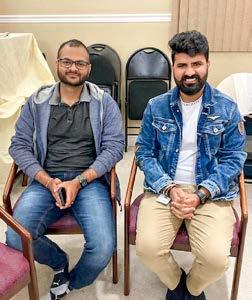

Thursday, September 12, 7:00 p.m.
Neighbours, please join us for our Annual General Meeting to hear about our activities. GCA members are invited to vote on our updated bylaws and for the 2024-2025 Board of Directors.
This event is an occasion to meet your Board members, enjoy refreshments and just be neighbourly.
All members of the GCA are welcome at our AGM and to apply to join our Board. For information, or to join or renew your membership, please visit glebeca.ca.
Please join us.
We are a stronger community with your voice.

By Carolyn Mackenzie
The City’s independent Urban Design Review Panel (UDRP) has major concerns about what will become of Lansdowne’s urban park. In July, it reviewed detailed plans for the proposed arena and surrounding areas, including the Great Lawn, the Great Hill/Berm and proposed new plaza area. The result was hardly a glowing review.
The opening statement of the panel’s report reads: “The Event Centre is an investment in the future of the city and in the image of the Capital. The Panel clearly understands the value and importance of this building at Lansdowne and advises that it should be a very special place within the city with exemplary design and event spaces.”
If the City’s own independent panel of design experts has to make that statement upfront, it’s pretty clear they think the proposed design does not cut it. The UDRP went on to cite numerous concerns that suggest significant rework is required.
The City and OSEG don’t seem to be listening to residents who have overwhelmingly indicated a desire to minimize the impact on greenspace and to increase pedestrian use at Lansdowne. If fixing Lansdowne’s financial problems means getting more people to come and spend more time and money at Lansdowne, we need to make it more attractive and people friendly. How will a plan that relies on vehicles serving commercial elements of Lansdowne driving through pedestrian/people areas accomplish this? Public gathering and greenspace need to be prioritized much more than what this plan offers. This will become even more important as the city’s inner urban area intensifies.
The problem lies in relocating the arena further into the park rather than rebuilding it where it is today, posing real challenges and setting up conflicts with pedestrians and people who just want to enjoy the space. Why? Because rather than developing a plan to limit vehicular traffic as much as possible to the edges of Lansdowne 2.0 and away from pedestrians, the City and OSEG’s plan relies on bringing more vehicle traffic (loading/unloading/drop-offs) into the interior where the new arena will be located. The plan is for vehicles to drive through a new public plaza area. A pathway encircling the Great Lawn is also being designed for use by vehicles.
A couple of UDRP comments highlight the problems. The italics are added.
“The Panel has major concerns with the proponent’s concept for a
communal gathering point located directly adjacent to a circulation pinch-point with a loading and servicing ramp. . . that area presents a major conflict and contradiction with the proposed idea of a gathering point in that area.”
But the Lansdowne 2.0 team’s reaction? It’s not a problem.
“The Panel has serious concerns with the prospects of an award-winning park design being reconfigured for vehicular access. The amount of park space being dedicated to vehicular circulation is problematic and should be reconsidered.”
And again, the Lansdowne 2.0 team’s reaction? It’s fine.
It deploys the typical strategy of presenting selective images to try to sell the plan. The relocated arena seems to be swimming in a sea of green grass. Except it won’t be. Where are the planned asphalt walkways? Where are the vehicles, including buses, pulling up to the front door of the arena? Where are the images of the “pinchpoint,” or pedestrian conflict zone, that the UDRP refers to?
Let’s be clear about the impact of this redevelopment on green space and park space at Lansdowne. The plan presented last November indicated a significant loss, although the City has continued to downplay this loss in staff reports and claims made verbally at meetings. This loss was the focus of an appeal by the GCA that was discontinued when the Ford government removed appeal rights through recent legislation (see John Dance article).
Last fall, Mayor Sutcliffe apparently told residents during a night of door knocking in the Glebe that the loss of greenspace “wouldn’t be that much.”
Was he misinformed? Or does he expect residents to believe that? The toboggan hill that doubled as casual seating for outdoor concerts? Gone. The Great Lawn? No longer so great. The proof was buried in city reports. The detailed plan reviewed by the UDRP outlines even further removal and compromise of greenspace.
Should the city ignore clearly worded recommendations from their own Urban Design Review Panel to rework the plan, as they did with the Auditor General recommendations around the financial strategy?
If you don’t think this is fine, let your views be known. Write to Mark. sutcliffe@ottawa.ca, with a copy to shawn.menard@ottawa.ca. Come to the August 11 Farmers’ Market, where City staff will share the site plan.
Carolyn Mackenzie is the planning chair for the Glebe Community Association (GCA).
By John Dance
It’s now law: community associations and most other third parties can no longer appeal municipal zoning changes, and Bill 185’s retroactive application means the more than $10,000 that the three local community associations spent on appealing the Lansdowne 2.0 rezoning is totally wasted as are the countless hours that volunteers spent on preparing the appeal to the Ontario Land Tribunal (OLT).
Bill 185, The Cutting Red Tape to Build More Homes Act, has eliminated a long-standing check on municipal and private developer plans to do whatever they want. Although it was often difficult and costly, community associations and other third parties previously had the option to challenge municipal zoning and official plan decisions by appealing to the OLT, formerly known as the Ontario Municipal Board.
The previous Liberal government strengthened third parties’ ability to appeal decisions, but this has all been thrown out the window by the Ford government in the rush to expedite developers’ planning approvals and get houses and anything else built.
In the case of the Lansdowne rezoning, the Glebe Community Association (GCA), with the support of Old Ottawa East Community Association (OOECA) and Old Ottawa South Community Association (OOSCA), appealed last December. The OLT accepted the appeal (they could have deemed it frivolous) and scheduled a hearing date in October. But in June, with the passage of Bill 185, the OLT cancelled the appeal.
Capital Ward councillor Shawn Menard asked city staff if the GCA would be reimbursed for incurred expenses, and staff responded that their opinion was there would not be any likelihood of the province reimbursing any person whose appeal has been ended by Bill 185.
Ottawa Centre MPP Joel Harden and Menard are jointly seeking redress from Housing Minister Paul Calandra but, at this writing, there has been no response from the minister.
“Minister, some might claim the GCA’s
decision to appeal the Lansdowne 2.0 development confirms why third-party OLT appeals are a problem,” Harden and Menard wrote to Calandra. “Such advocates may, mistakenly, suggest that OLT appeals of this nature thwart the expansion of homes in a housing crisis. However, the GCA has supported the suspension of third party appeals to the OLT over affordable housing projects. Their concern with Lansdowne 2.0 (which has zero affordable housing units) was the loss of city-owned urban greenspace in a high-density residential area.”
Harden and Menard go on to say that the government’s target of 1.5 million new homes in the next 10 years is “a worthy and important goal [but] that cannot come at the expense of democratic planning at a local level. As we ramp up efforts to create affordable and accessible homes, we must ensure residents are included in the design of our communities. Their voices matter.”
“At a minimum, we would ask your government to compensate community groups for their costs with OLT appeals that had been incurred while following due process, yet now have been retroactively denied in the weeks after Bill 185 came into force,” they conclude.
To the Government of Ontario, the $10,000 that the GCA incurred may be a pittance, but this amount is approximately the total expenditure of the community association in an average year. Similarly, the $500 contribution of the OOECA is about a quarter of the funds raised annually through the membership campaign so that the cancelled appeal constitutes a real financial blow.
“The CGA followed due process in good faith,” says Alexandra Gruca-Macaulay, chair of OOECA’s Lansdowne committee. “It is not simply a matter of “community voices” not being heard, but that appeals functioned as a check and balance on possible corrupt practices.”
John Dance is a resident of Old Ottawa East, a frequent visitor to the Glebe and Lansdowne Park, and a member of Old Ottawa East Community Association’s Lansdowne and planning committees.
This article appears with the consent of the author and The Mainstreeter

Saturday & Sunday September 14 & 15, 2024 10 a.m. to 4 p.m.
Glebe Community Centre 175 Third Avenue, Ottawa

Anne R. Thompson
Beata Jakubek
Bill Keast
Cara Lipsett
Catherine Schissel
Christiane Kingsley
Dale Taylor
Daniel D. St-Cyr
Denise Guillemette
Erwin Mistlberger
Glenda Krusberg
Heather Lovat-Fraser
Ingrid Black
Jane Cass
Janie Park
Janis Fulton
Janis Miller Hall
Jaynie Coulterman
Judi Miller
Karen W. Mackay
Katrin Smith
Kristina Murray
Linda Loder
Luminita Serbanescu
Lynne Morin
Margaret Chwialkowska
Marie Arsenault
Martha Markowsky
Rose Marie Roy
Roy Brash
Roy Whiddon
Therese Boisclair
Tricia Wilmot Savoie
Wendy Quirt




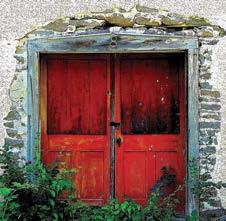












By Carolyn Mackenzie
Ottawa’s Auditor General (AG) says the cost of Lansdowne 2.0 could be $75 million higher than estimates presented just last November, bringing the total bill for the redevelopment to close to half a billion dollars.
Nathalie Gougeon’s findings following a close look at the city’s Financial Strategy of Lansdowne 2.0 – basically what it will cost and how we will pay for it – were presented June 11, and they were not good news for supporters of the deal with OSEG. As well as rising costs, she also warned of falling cash distributions to the City – they could be $10 to $30 million less than estimated, meaning less money to pay for the redevelopment leaving taxpayers to fill the gap.
On top of that, the AG pointed to significant risks with the city’s revenue forecasts, because the financial plan wouldn’t see the City get much cash from Lansdowne until the latter half of the 40-year deal. Forecasting 20 to 40 years out is always riskier than a short-term estimate. But the City seems fine taking on this additional risk, forcing the next generation of taxpayers to deal with any shortfalls. Of course, decision-makers now will no longer be around to be held accountable.
Importantly, last November, staff was given the go-ahead to keep developing the plan for Lansdowne 2.0. They were also directed by Council that if something material were to change, staff must come back to Council with an update.
But staff don’t accept the AG’s recommendations. By not accepting them, they are not technically obligated to update Council on what a revised Financial Strategy would look like. What could it cost taxpayers if the AG estimates are closer to reality? We don’t know, nor does Council. What is the point of the AG spending time on an audit if her findings are ignored?
Taxpayers were initially told that Lansdowne 2.0 would cost us nothing. Last fall, Mayor Mark Sutcliffe promised that it would only cost $5 million a year (if all goes very well) for the next 40 years. But the AG report suggests it could be a lot more.
At the same time, as the City grows, the plan is for a much smaller 5,500 seat arena that will be too small to accommodate the Professional
Women’s Hockey League crowds that filled the Civic Centre last season or to draw bigger-name concerts. There will be no roof for football fans. There will be no green roof on the arena, whose relocation will result in significant loss of public park and green space. Berm as toboggan hill and football or concert seating? Gone.
If costs continue to rise while park elements are diminished, will Council have the courage to insist on a better plan at a final decision point 18 months from now? Or will they just point to all the time and effort staff put into this deal, ignore the obvious weaknesses, hold their noses and say they don’t see how they can say “NO”? They don’t have another option, as Council only asked staff for one. And how soon after will there be a call for more spending through Lansdowne 3.0?
We need a responsible solution for the financial failure of Lansdowne. Lansdowne 2.0 is a an increasingly expensive proposal, so we must demand that Council is properly informed. Council must be clear-eyed about the debt we are taking on as taxpayers for what looks like a very compromised redevelopment. If it’s not good enough, the time to say so and to insist on another option is now, not in 18 months. Let your views be known. Write to Mark.sutcliffe@ottawa.ca, with a copy to shawn.menard@ottawa.ca
Carolyn Mackenzie is the planning chair for the Glebe Community Association (GCA).



Sarah Routliffe GNAG Executive Director
N 613-233-8713
Many people say that life is short, and while I agree with that sentiment, I also believe life can feel very long without milestones and holidays to celebrate. For me, celebrating important events and being there for the people I care about is the key to a life full of joy and happiness. Whether it’s a birth day party, a wedding or a baby shower, you can count on me to be there, ready to celebrate and contribute, even if it’s just by baking a special treat.
Over the past 50 years, GNAG has been a cherished gathering place for celebrating milestones. We are seek ing 50 memories for 50 years, and we need your help! We invite you to share your memories, stories and experien ces to help us create a truly memorable event. Leading up to GNAG’s 50th anni versary party on May 31, 2025, we will post these memories on social media.
This is a call to action for everyone who has loved GNAG, taken a program, attended an event or worked in our building. Please send in a photo along with a quote, sentence or short para graph from any decade that GNAG has been around – bonus points if you can tell us the year the photo was taken!
Help us bring all your memories and special moments to life for this special event. Submissions can go to: 50years@gnag.ca.
Fall programming
We’re not excited for summer to end (summer forever!), but we do love the exciting activities that fall brings to the Glebe Community Centre. Fall tends to be one of our busiest registration per iods, so make sure to check the guide in advance to find something that tickles your fancy!

Fall registration opens at 7:00 p.m. on Tuesday, August 27! The guide will be available online a few weeks in advance, so keep an eye on our website at www.gnag.ca.
Youth programs managerwelcome Dylan
We have some exciting news at GNAG, starting with an acknowledgment of Katie Toogood and her outstanding
ector Lauren Saindon and choreographer Ciana Van Dusen are back for another season of performance in a most encouraging community setting.
Seniors survey (65+)
We aim to serve the senior population in our community effectively. To help us achieve this, we’ve created a survey that will be available on our website. Please take a moment to fill it out so we can ensure we provide the best possible service.

Heading back to work or school? We have new fall fashions on the floor now. Summer all 80% off.
service.

Gladstone Ave. 613-680-2600 jon.beckman@manulifesecurities.ca www.beckmanwealthmanagement.ca







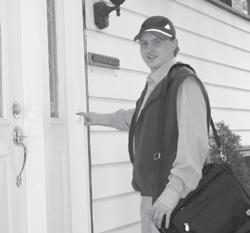



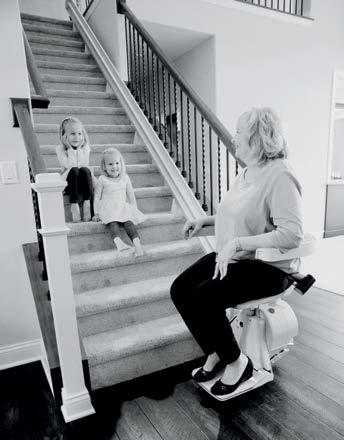
John Crump President, Glebe Community Association www.glebeca.ca
You live in the Glebe. You’re interested in the issues that affect your community. You enjoy working with a likeminded group of people. You have ideas and energy. Good news, there is a place where you can help make a difference – the Glebe Community Association is looking for volunteers to join the board that will be elected at its Annual General Meeting on September 12.
The GCA has a long history of working on behalf of the community, and all its efforts rely on people volunteering their time. There are a number of positions available. If you would like to join us or want more information, go to glebeca.ca/board/ or contact vp@ glebeca.ca
The next year will be busy. The City is pushing ahead with plans to (again) redevelop Lansdowne and is developing new zoning bylaws that could have a direct effect on the community. The GCA will continue to advocate for more affordable housing, and we will continue to work with community partners on safety concerns. Transportation issues are on the horizon as always. And we will create a new governance committee as there is a lot more work around improving our practices and dealing with some of the issues raised by the Ontario Not-for-Profit Corporations Act (ONCA).
At the AGM, association members in good standing will vote for a new board of directors and approve bylaw changes required under the ONCA. A package of information, including the new bylaws, financial reports and other motions, will be sent to GCA members a month before the AGM for approval at the meeting. Speakers at the AGM include political representatives from the city, province and federal government.
The AGM will be a time to socialize with your neighbours (there will be snacks) and to recognize retiring board members.
Sometimes you have to wonder whose voice gets heard in this province. Those lobbying for expanded alcohol sales appear to have the ear of the provincial government. Those calling for improved health care, more affordable housing – and the list goes on – have a harder time being heard. And now that the Cutting Red Tape to Build More Homes Act is in force, just about any voice that questions a development decision will be crying in the wind.
When the bill came into effect in early June, the GCA’s appeal to the Ontario Lands Tribunal against the rezoning of parkland at Lansdowne to allow the construction of an arena was dismissed without being heard. Although we had a hearing date set for October, the bill was made retroactive, meaning any appeals scheduled before the legislation was introduced in early April were disallowed.
We were not alone in having our appeal dismissed. From now on, no third-party organization anywhere
in Ontario can appeal land rezoning for any reason. If democracy thrives in daylight, this legislation covers what should be an open process with a shroud and undermines citizens’ democratic rights. Despite the setback, the GCA will continue to advocate for important planning decisions to be made through open discussion and citizen involvement.
At the time this was written, donations to the Ottawa Food Back from the GGGS were still being tallied, but the total to date – $6,500 – was ahead of last year. Congratulations and thank you to everyone who contributed. Planning will begin this fall for next year’s garage sale and will build on some of the new features from this year, including the participation of the St. John’s Ambulance service, a water station, a marching band that paraded through the neighbourhood and more public toilets, to name a few.
The last GCA meeting in June received a year-end financial statement and balance sheet. We are ending the year with an $8,000 deficit. Changes in expenses from prior years include increasing our liability insurance to $5 million, which is required to access City of Ottawa funding opportunities. Additionally, we incurred legal fees related to the Lansdowne zoning appeal and for the preparation of our updated bylaws to comply with the Ontario Not-for-Profit Corporations Act. With funds in reserve, the GCA will be able to cover this deficit and still have $40,000 in the bank. So, we are in good shape. But remember, membership fees are our only source of revenue, other than special project grants. If you haven’t bought a $10 membership for this year, please go to glebeca.ca/membership/.
Annual General Meeting, Thursday, September 12, 7-9 p.m. at the Glebe Community Centre.


Shawn Menard
Councillor, Capital Ward
N 613-580-2487
www.shawnmenard.ca
Trees are an integral part of our urban landscape. We all know the trees in our neighbourhood, their individual burls, the nuts or fruits they make in the summer and the colours they turn in the fall. With hotter and wetter summers, wildfire smoke and increasing development, we also are grateful for what trees do to cool down sidewalks, filter the air and increase stormwater infiltration. That’s why a promise to plant one million trees made it into the mayor’s campaign platform, and every day we hear from residents who want more trees planted on their street or are upset to see large, old trees coming down.
But there is some good news. At the Environment and Climate Change Committee (which I am honoured to chair) on June 18, staff presented two important components of the emerging tree-planting strategy. The first is a commitment to move toward a proactive approach to planting in the city right-of-way. Community Associations for Environmental Sustainability (CAFES) have been calling for this approach, which Montreal has pursued with excellent results. Currently, only one third of the trees in the right of way that get taken down in Ottawa –whether because of age, storm damage or street reconstruction – are replaced. And under the current program, residents must request a replacement tree and then water it during the establishment period.
Under the proposed new approach, trees would be replaced automatically where space and conditions permit. This would result in approximately 2,000 new trees planted along public roadways each year. While this comprises a small percentage of the total trees planted annually, it is still a significant contribution toward Ottawa’s canopy cover target of 40 per cent that was approved in the Official Plan. Residents would be informed of the plans to plant a new tree in front of their house and would have the opportunity to veto the planting if they oppose it. From an equity perspective, we know that certain areas of the city feel hemmed in by concrete while other neighbourhoods are green, cool and pleasant to walk around. The reasons for this are usually based on income and on economic drivers like industry. Community members in the Glebe and across Capital Ward have been calling for neighbourhood-specific targets for tree canopy cover, so that planting can be targeted toward the areas that need it most.
Staff are proposing to use the American Forests’ Tree Equity Score methodology to assess canopy cover data in conjunction with socio-economic and health measures of inequality and to report back by the end of this year with an action plan. We have been waiting for some time for this granular data,
which uses aerial photographs and geospatial technology. The American Forest’s methodology is widely used, which will allow Ottawa to take best practices from other cities and learn from their mistakes.
Other important changes include greater flexibility in the Commemorative Tree Program to allow for plantings in honour of significant events or community leaders by covering increased costs for staff labour, maintenance and plaque or geotag installation. Lastly, staff are recommending a new program to support tree planting on private lands. Through this program, they plan to distribute 50 trees across each of the 24 wards, in priority areas, with support to ensure that they thrive.
From a climate resilience perspective, the Tree Planting Strategy is also trying to increase the diversity of species in Ottawa’s urban forests. Hidden Harvest has been calling for more fruit and nut trees to supplement local food production. With more frequent violent storms, we need varieties that can withstand the wind, rain and freezethaw cycles. Our communities form an invaluable resource in identifying potential tree planting locations, monitoring tree health and advocating for the retention of trees in our parks and public spaces. While the creation of an Outreach and Stewardship Coordinator position is a great first step to support these relationships, there is potential to go further in partnering with community associations and other environmental groups.
Of course, nothing occurs in isolation. At the time of writing this, two major related pieces of policy are going to committee. The Wildlife Strategy deals mainly with human-wildlife conflict, which touches on land management practices and broader concerns of ecosystem health. And the Infrastructure Master Plan projects how the City will manage its storm sewers, water pipes, roads and other supporting services to provide for a growing population. Both of these policy frameworks impact and are impacted by the way that we manage our urban forests.
Shawn Menard is City Councillor for Capital Ward. He can be reached at CapitalWard@ottawa.ca.

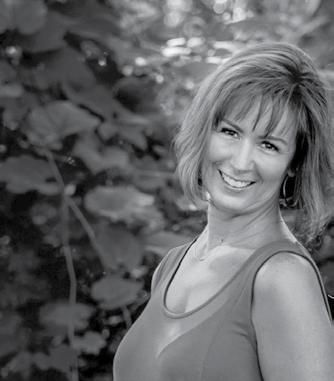




By Dianne Breton
On September 8, National Grandparents Day, One World Grannies (OWG) is celebrating with an awareness-building bridge crossing at the popular, newly repurposed Chief William Commanda Interprovincial Bridge in west-central Ottawa.
Grandmother groups across Canada that raise funds for the Stephen Lewis Foundation’s work supporting grandmothers in sub-Saharan Africa will be celebrating the day in diverse ways. Here in Ottawa, OWG is inviting regional Granny groups and the public in the Ottawa and Gatineau region to join us and show support for grandmothers raising their grandchildren due to the HIV/AIDS pandemic which is still affecting their countries and their families.
Everyone is invited to cross the repurposed bridge and enjoy the beautiful views of the Ottawa River from Ottawa to Gatineau. They can also pin their own messages of solidarity onto temporary clotheslines put up for the occasion.
The event will take place from 10 a.m. to 2 p.m. Invited distinguished guests will say a few words, starting at about 11 a.m. We are thrilled that
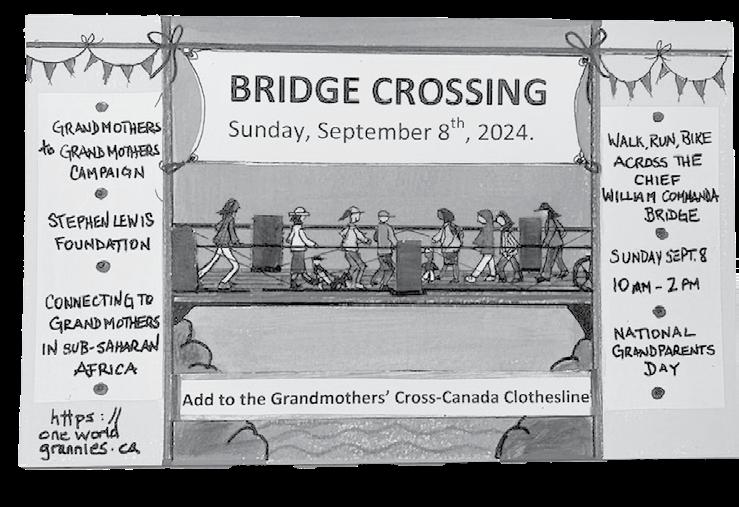
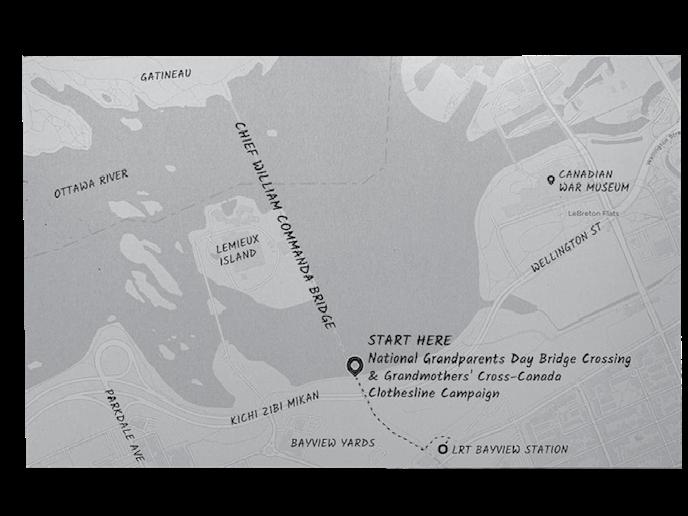

The Unknown Mother, by Ainalem Tebeje
Review by June Coxon
When Ottawa author Ainalem Tebeje launched her fourth book at the Glebe Community Centre on May 18, the room was filled with many interested people. Introducing Tebeje was her eight-yearold great niece Eldana Terazu Benhan. The launch speaker was Denise Amyot, former public servant and CEO of Colleges and Institutes Canada.
Tebeje’s new book, The Unknown Mother, is the biography of her mother, Waytinu Tasew. It tells the brave story of her mother’s extraordinary life.
Although she grew up as a child in a traditional society in a remote village in Ethiopia, Tasew rebelled against the unfairness of the life of girls and women in her village. They, unlike the men and boys in the village, had to work

Claudette Commanda, chancellor of the University of Ottawa and a grandmother herself, will be on hand to speak. Kitchissippi Ward Councillor Jeff Leiper is expected to be there along with other city councillors from Ottawa and Gatineau.
Information will be available about the Stephen Lewis Foundation’s Grandmother to Grandmother Campaign and the community-led work it supports in sub-Saharan Africa, and OWG members will be there to answer questions. Donations will be gladly accepted, or donations can be made on the website (oneworldgrannies.ca) and will go directly to the Stephen Lewis Foundation.
Come and learn about the work of the Grandmothers Campaign while celebrating grandparents everywhere and enjoying a walk, run or ride across the bridge spanning the Ottawa River.
The easiest way to reach the bridge is via the bicycle path along the river, or by exiting the Bayview LRT station and heading towards the river. See you in September!
Dianne Breton is a volunteer with One World Grannies and an organizer of this first-time event.
until late at night and get up at sunrise to start work again. As Tebeje writes, “Women had to justify their existence by working to exhaustion and birthing until they no longer could.”
Tebeje recounts stories her mother shared with her over the years about her desire for a different kind of life than the one her village offered women and girls. The biography begins in Sequalla, Ethiopia, where Tasew was born and follows her through various traditional and untraditional stages of her life.
At a very young age Tasew concluded that she and her village were not compatible and that she wanted a different lifestyle. So as a young teenager she ran away from home, travelling to various cities and villages before eventually finding a place to call home. The story relates some of the struggles as well as joys she experienced over the years as she tried to achieve her goal.
Recalling her mother, Tebeje wrote, “She had a sharp mind and defiant courage.”
For readers who know little about Ethiopia this book is educational. As
we follow the mother’s journey through life we also learn about some Ethiopian traditions and ways of life that the author weaves throughout the story.
Like Tebeje’s other books, this one engages and captivates readers. At the book launch of The Unknown Mother, an attendee wrote, “The book about your mother is a pure delight to read.”
The author came to Canada from Ethiopia as a refugee. In addition to being an author she has worked as a journalist, reporter, correspondent, sub editor and public servant. Her other books include Cultural Interaction Between Canadians and Ethiopian Newcomers, 1989; My Love Story in Broken English, 2018; and The Refugee, 2022.
The Unknown Mother, published by BAICO Publishing, is available at Octopus Books, where the website says this is “a gripping story of the extraordinary life of a fugitive who grew up fleeing repressive cultures.”
June Coxon is an Ottawa freelance writer, the author of two children’s books.



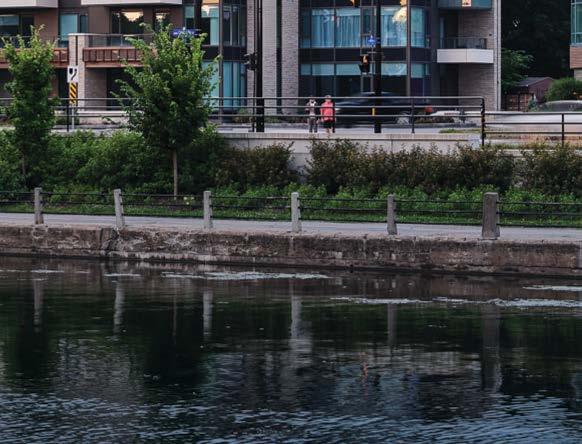





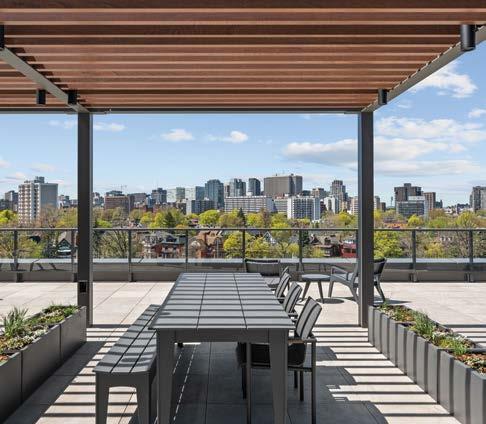
By Caroline Warburton
Join us on Sunday, September 15 from 1 to 4 p.m. for a unique opportunity to tour five homes in Ottawa’s historic Glebe neighbourhood.
Your ticket not only grants you access to these beautifully curated homes, it also supports a subsidy program benefitting Ottawa families and children with special needs, enabling their participation in programs offered by the
Glebe Neighbourhood Activities Group (GNAG). Additionally, 10 per cent of ticket proceeds will be donated to Haven Too, an emergency youth shelter operating out of Fourth Avenue Baptist Church, providing essential services to vulnerable youth.
This self-guided tour offers the chance to explore at your own pace, with knowledgeable volunteers stationed at each home to answer any questions. You can stroll through the




neighbourhood or take advantage of our complimentary shuttle bus service. After your tour, unwind at the Glebe Community Centre from 2:30 to 5 p.m. with a complimentary tea service and delicious homemade baked goods.
We extend our heartfelt thanks to the homeowners who generously open their doors for this event, as well as to the dedicated volunteers whose efforts make the Glebe House Tour possible. Tickets are priced at $40 in advance


This home has a delightful European ambiance, featuring an open-concept main floor with a wood-burning fireplace. The homeowners meticulously planned and oversaw the renovations, including all decorating decisions. The stunning red kitchen and the bathroom cabinets exemplify the creative use of Ikea products. Adding to its charm, the tiny powder room on the main floor boasts a quaint slanted door. Don’t forget to gaze up at the eclectic ceiling light fixtures as you explore each room of this inviting
and $45 on the day of the event, available starting August 15 at the Glebe Community Centre or online at gnag. ca under Events. Children aged 12 and up require their own ticket; babies in arms are welcome at no additional charge. Tickets are limited, so secure yours soon! For further details, please contact clare@gnag.ca.
11 Third Avenue
This three-storey rowhouse, located a few houses west of the canal, underwent a complete renovation by Emma Doucet, the owner of the award-winning Grassroots Design and Build. Renowned for their vibrant use of colour and natural materials, Grassroots transformed this home with sage-green cabinets and beautiful wooden beams. The main-floor powder room features a barnboard backsplash and lively wallpaper. On the second floor, there’s an open-concept laundry room at one end and a spacious office area at the other. The thirdfloor master bedroom and bathroom exude style and coziness.











This house was purchased in 2021 during the peak of the pandemic and served as a canvas for one of the homeowners to complete assignments for her interior design course, ultimately leading to the founding of her own company, dapper Home. The remodel cleverly incorporates historic details alongside modern updates. The stunning La Cornue stove takes centre stage in the luxurious kitchen that also includes beautiful custom cabinets and a lovely Blackstone granite island. During your visit, be sure to check out the converted shed, now a heated home
and retreat.



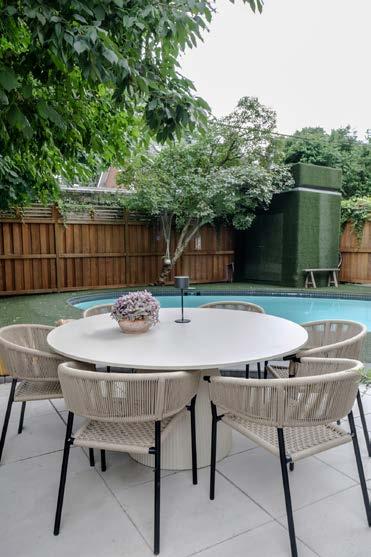
BY SUZANNE MCCARTHY
This quaint house, constructed in 1900, was recently added to the heritage register by the city due to its distinctive characteristics. The living room exudes warmth and charm with its striking wallpaper, modern Oushak rug, plush velvet sofas, and ceiling medallion. In the dining room, an antique pine harvest table and dresser, cherished heirlooms from the homeowner’s parents, add a nostalgic touch. At the back of the house, a bright and airy family room addition offers a refreshing atmosphere. Throughout the home, original artworks complement the thoughtful use of colour and wallpaper, enhancing its unique appeal.
MCCARTHY
PHOTOS BY SUZANNE
This grand and luxurious home underwent a meticulous fouryear renovation, carefully managed by the homeowner. The elegant Bocci light fixtures and contemporary furnishings from Alteriors are perfectly complemented by exquisite antiques from Champagne dit Lambert. The second floor features a spacious open landing leading to three children’s bedrooms and a bathroom with a yellow sink sitting on top of a quartz waterfall counter. On the third floor, you’ll find a vast bathroom with a stunning walk-in closet, an office and the primary bedroom with a clawfoot bathtub at one end.
Caroline Warburton and Suzanne McCarthy are members of the annual Glebe House Tour organizing group.

By Cecile Wilson
CO 2 at Mauna Loa, 26 July 2024: 424.52 parts per million (ppm)
As I read reports of the effects of extreme weather, I can’t help but notice a frequent omission. While ample attention is paid to adapting to these events, there is often no mention of mitigating them. That is, how do we reduce the likelihood of extreme weather in the first place?
Granted, when you are faced with an imminent threat, you need to respond immediately. If there’s a wildfire, you evacuate people and send in firefighters. If there’s a flood, you surround homes and businesses with sandbags to try to hold back the water and then rescue people if that fails.
It also makes sense to incorporate long-term strategies to deal with extreme weather. If your harvests have been damaged by alternating drought and flooding, heat and cold, you might diversify your crops in the hopes that at least one of them will endure whatever moisture and temperature variations the climate delivers. City services can proactively install air-conditioning for vulnerable people in anticipation of ever-increasing heatwaves.
In some cases, an action that is undertaken as adaptation can also serve as a mitigation. For example, a heat pump installed to provide cooling on hot summer days (adaptation) can also be used in the winter to provide heat without using fossil fuels (mitigation).
An effective and humane response to severe weather caused by climate change requires both adaptation and mitigation. A boating metaphor neatly illustrates the problem. You are in a leaking boat that is taking on water. The first thing to do is patch the leak (mitigation), then you can use a bucket to bail out the boat (adaptation). Mitigation deals with the root cause; adaptation deals with the effects. If you don’t address the cause, your adaptation measures will be





OTTAWA-GATINEAU
OTTAWA-GATINEAU

CLIMATE MARCH 2024
CLIMATE MARCH 2024


















in less frequent severe weather. To use another metaphor from transportation, just as a car does not stop immediately when you slam on the brakes, global warming does not stop as soon as emissions drop. And we are nowhere near slamming on the brakes on climate change.


Saturday 21 September 11:00



https://www.fridaysforfutureottawa.org
responding to a constantly moving target.
Given that climate destabilization is primarily caused by carbon dioxide in the atmosphere, the two main ways to mitigate the problem are to reduce emissions by significantly reducing the burning of fossil fuels and remove the carbon dioxide that is already in the atmosphere. Natural infrastructure such as trees, forests, grasslands and oceans can perform this function. Unfortunately, Canada’s boreal forests have been so decimated by fire, pests, disease, drought, and storms that they no longer act as carbon “sinks.” Instead, they have become emitters of carbon. Oceans are nearing their carbon-carrying capacity and turning acidic as they do so. This situation emphasizes why it is so urgent for politicians to enact policies that reduce carbon emissions.
The extreme weather that we are experiencing right now has been made many times more likely by burning various fossil fuels since the start of the Industrial Revolution. There is a lag time between reducing emissions, lowering carbon dioxide in the atmosphere, and the re-stabilization of climate systems resulting
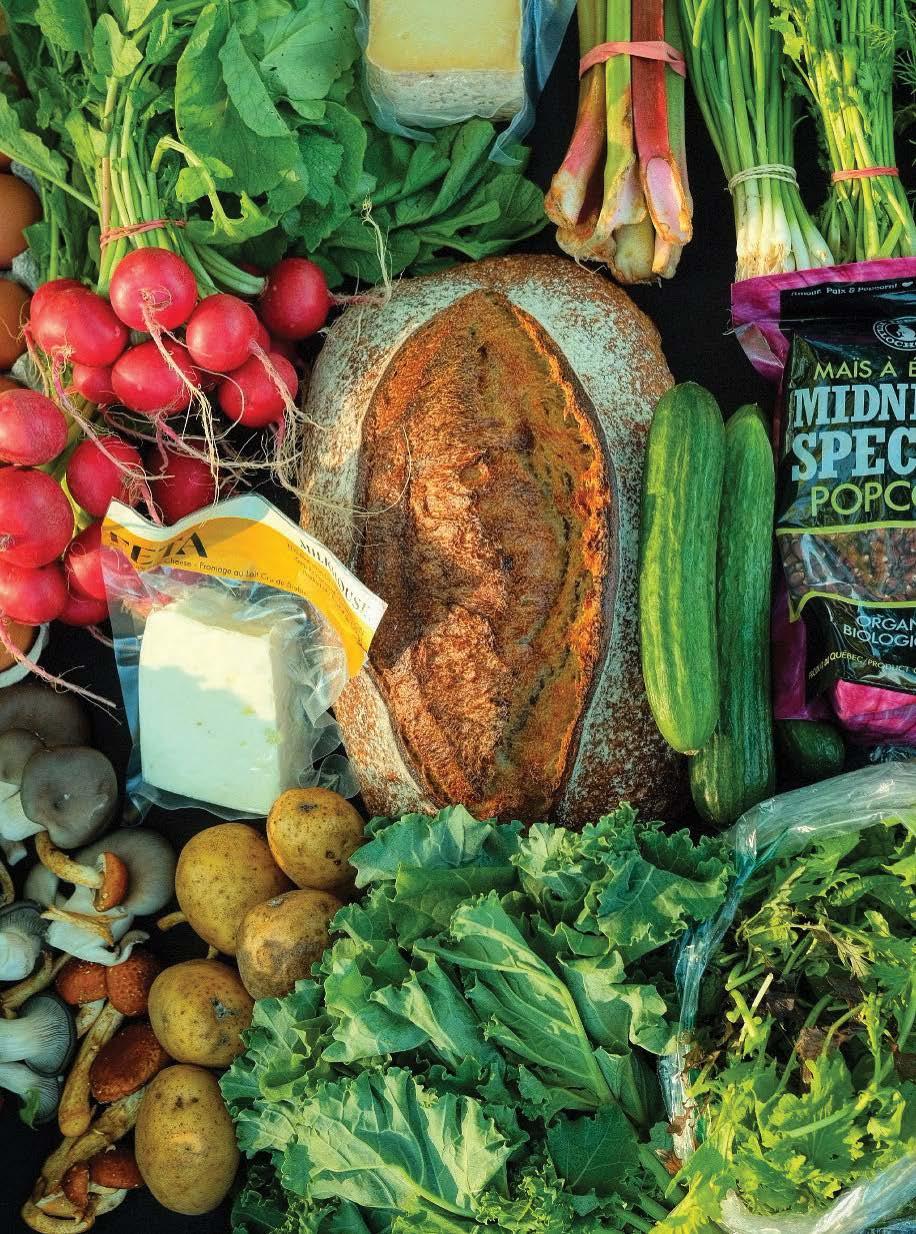
The most frustrating part of the problem is that we already have many technologies that can help cut emissions in half by 2030. Solar and wind power are now relatively cheap; battery technology is improving. So why are we seeing so little action on reducing our reliance on fossil fuels? It seems the task of mitigation has been shifted primarily to individuals and small businesses. Think of the whole “carbon footprint” concept initiated by British Petroleum to shift the focus off the fossil fuel corporation; the presence of RBC, Scotiabank and TD among the top 12 fossil-fuel financers in the world; the federal government’s funding of the Trans Mountain and Coastal Gas Link pipelines; the provincial government’s support for building more gas electrification plants; and the City of Ottawa’s sluggishness in implementing the mitigation aspects of its Climate Change Master Plan.
Effective mitigation action will decrease both the need for and the cost of adaptive measures. Politicians and corporate leaders need to know that a large number of people support “prompt and ambitious” measures. In 2019, the Climate March sent a clear message in favour of climate action. Let’s do the same this September.
What: 2024 Ottawa Climate March
When: Saturday, September 21
Time: 11 a.m.
Where: Starting point at Ottawa City Hall
To volunteer, collaborate, or add yourself to the mailing list, contact www.fridaysforfutureottawa.org.
Cecile Wilson is a Glebe resident and appreciates the opportunities for fossil-free transportation it provides.

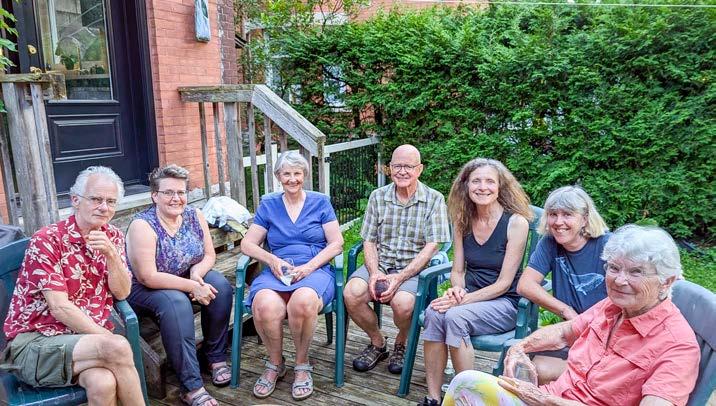
By Della Wilkinson, Kate Reekie and Jennifer Humphries
A series of Coffee Houses on Sustainability brought over 900 Ottawa residents together to build knowledge and to motivate more people to choose sustainable lifestyle options. The six events were co-funded by the City of Ottawa’s Community Environment Project Grant Program, the Glebe Community Association and the Community Associations for Environmental Sustainability (CAFES). Several Bank Street businesses provided free coffee and cookies: Bridgehead, McKeen Metro, Happy Goat, Starbucks, Wild Oat Café and Second Cup. This is an overview of things we learned by attending.
Homes & Energy
#1 Old houses can be adapted to our changing climate
By considering energy, carbon and resiliency as part of retrofit objectives, you can reduce energy bills while improving thermal comfort, air quality and resiliency to power outages. The first step is to reduce heat loss in your house by sealing gaps, adding insulation and upgrading to high efficiency windows and doors. If your furnace and air conditioner don’t need replacing for several years, explore adding solar panels to your roof in the short term so that you have renewable energy for that heat pump when the time is right. Consider the City’s Better Home Loan Program as an option to finance such changes.
Reducing Your Carbon Footprint
#2 Everyday choices make a difference, but some have bigger consequences than others.
Project Neutral’s carbon footprint estimator asks seven simple questions and estimated one of the authors’ household carbon footprint within a few percentages of a more detailed calculator that required details on where they live, utility bills, how far and by what mode they travel. The Carbon Literacy Challenge revealed how different choices contribute to our impact on climate change. Breaking down our relative levels of carbon consumption into heating, transportation and other categories helped to decide where best to focus efforts.
#3 Plant native plants and trees (not cultivated varieties or invasive species).
Native plants and trees provide nesting sites, food sources and corridors for wildlife to move between fragmented areas in urban settings. They are low maintenance and have evolved to survive in our climate, hence they require fewer added resources such as water and chemical amendments. Cultivated plants are genetically altered to have different characteristics i.e., bigger blooms, different coloured foliage, etc., but the plant may be unusable/inedible to native wildlife. Cultivated plants have fun descriptive names following the Latin name. For example, Phlox divaricata (native to Ontario) versus Phlox divaricata ‘Blue Ribbons’ (cultivated version).
#4 Keep the stormwater on site rather than overwhelming city sewers
Rain Ready Ottawa offers e-courses and rebates for a variety of stormwater management options as shown. The Glebe is a secondary stormwater retrofit area eligible for e-courses.
#6 Understanding the health benefits of a 15-minute neighbourhood
The Glebe is a 15-minute neighbourhood, but what factors impact whether we choose to walk, bike or drive? Would a Walkable App with information on the weather, local roadworks, traffic, scenic options and amenities help us make more sustainable transport choices? There are numerous models of e-bikes including those designed for transporting children.
Zero-Waste Living
#7 Buying less; buying better
For most people, adopting a zero-waste lifestyle will not involve the widely reported extreme of reducing their waste to fit into one mason jar per year. Realistically, it is about becoming more conscious about the waste we produce – and that includes recycling, which we should also be reducing! Every time we think we need to buy something, think “Do I really need this?” or “Is there another way I could meet my needs?” First ask if you can borrow the item from friends, family or neighbours. If not, then can it be rented? Then, can it be purchased used? If you follow this line of thinking, the planet and your pocketbook will surely thank you!
Climate Risk
#8 Things we can do to protect our basements from urban flooding
Urban flooding occurs when stormwater or sewage backs up into the basement or enters the home after runoff has accumulated on the ground. The City of Ottawa’s Three Steps to Cost-Effective Home Flood Protection offers suggestions at zero cost (maintain storm drains, eavestrough, plumbing, etc.), under $250 (add window well covers, downspout extensions) and over $250 (install a backwater valve, install a sump pump).
Coffee Houses on Sustainability
#9 Advocate for a better environment
Each event raised topics on which the City of Ottawa is seeking public feedback, such as the new zoning bylaw, Bank Street active transportation and transit priority study, climate resiliency strategy and more. A recent survey on Engage Ottawa showed most respondents supported limiting idling to one minute with set temperature thresholds.
#10 Knowledgeable neighbours live in your community
Considering making a sustainable change? Ask around as there are residents living close to you who have already made sustainable choices with respect to their homes, energy, mode of transport, consumption, waste and greenspaces. Start a conversation, maybe over a cup of coffee, then gather trusted information and turn thought into action!
Della Wilkinson, Kate Reekie and Jennifer Humphries are members of the Glebe Community Association’s Environment Committee and helped to organize the GCA coffee houses on sustainability. Follow the GCA Environment Committee on Instagram @gcaenviro175.


Transportation
#5 There’s a lot of misinformation circulating about e-vehicles
Do EV batteries need to be frequently replaced? No, they should last for the lifetime of the vehicle, after which they can be used as stationary storage before being recycled into new batteries. Charging EVs takes too long! Most of the charging happens at home or, thanks to fast charging (20 to 60 minutes), while we shop or eat. EVs don’t work in the cold! The low centres of mass mean they handle well in snow and preconditioning means no scraping off ice and near-instant heat.





In October, fate brought Brian and Miriam together when Miriam joined us for a trial stay. From the moment they met, Brian thought “wow!” and knew there was something special about Miriam–she gave him butterflies like no one else had before. Their love story truly began when Brian asked Miriam to dance, a moment that marked the beginning of their journey here. Within a few short months, they knew they had found their forever love and were engaged. On June 8th, surrounded by friends and family, they joyously exchanged vows and started their new chapter together.
tour

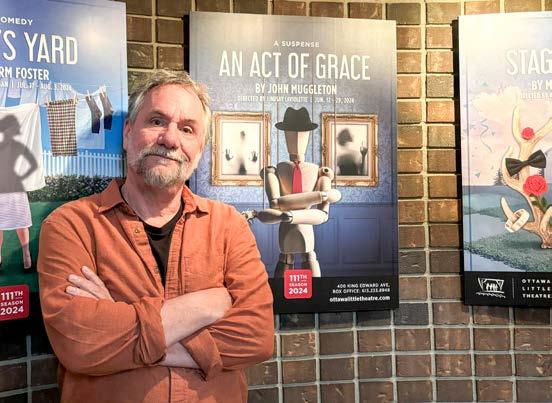
By Alexa MacKie
Before John Muggleton became a playwright, he was a dissatisfied Ottawa theatregoer.
“I was sort of dissatisfied with these local plays that were just not possible, and yet they were being presented as a possible situation,” he said. “You’ve got to give the audience a story with a possible element to it. It can’t be impossible or silly. That’s just lazy writing.”
Muggleton gave an example of a show whose title he can’t remember (“Something like, Babble, but it wasn’t Babble.”) He recalls the play took place inside a fake police station, and the plot centred on a scheme to murder a father in front of his son.
Muggleton listed the plot details he found implausible: leasing a New York building to execute the murder plan and finding extras and police cars to make the location believable, among them.
“How can you present that story as, ‘Oh, never mind the details. It’s all about the trap’?” he said. “That’s not respecting the audience. You’ve got to explain everything.”
As an actor, director and playwright with experience in Ottawa, Toronto and Edinburgh, Muggleton wants to ensure his work is believable.
Muggleton and I spoke for 90 minutes before the closing performance of An Act of Grace. The play ran at the Ottawa Little Theatre from June 12 to 29, and a shortened version is slated for the Edinburgh Festival Fringe from August 2 to 24.
“There’s no social message,” Muggleton said about the play. “There’s enough finger wagging and social messaging at other theatres. I just want people to have a good time.”
If the closing night audience’s laughter and gasps at plot twists were any indication, An Act of Grace is both a playful comedy and a suspenseful thriller. We follow Chuck (Kurt Shantz) and Tony (Christian Giansante) who are lured to the home of a wealthy widow named Grace (Venetia Lawless). The plot moves at a breakneck pace as the actors stumble about and cut each other off.
In spite of the whirlwind plot, Muggleton insisted, “Everything is backed up and everything is explained.”
Chuck and Tony are tricked into Grace’s plot to plan her own murder. Muggleton’s writing shuts down plot holes, as Lawless elegantly delivers her character’s monologues, highlighting Grace’s plan:
“It’s a challenge to play a character that’s the bad one, but it’s also quite fun,” Lawless said. “Playing with the twists and turns of the plot is really
appealing, because we’re taking the audience on a ride.”
“It’s a real honour to play these words John crafted. I have the utmost respect for him as a playwright.”
Lawless will reprise her role in Edinburgh, along with Shantz and Giansante, with Lindsay Laviolette remaining as director. Laviolette worked on previous iterations of An Act of Grace and Burn, Muggleton’s first play that’s been staged in theatres around the world.
Laviolette said it’s “gratifying” to bring Muggleton’s work to life for a receptive audience.
“I would often sit at the back of the house and just listen to people mumble or murmur as they’re reacting to things,” she said. “That’s something really special, because it means the script and the show are landing for John.”
That landing is what Muggleton said he looks for, hoping that his work sticks for what he calls the “drive-home conversation.”
“I like characters pushed into a corner where they see very little way out. I want the audience to think, ‘What would I do in that situation?’”
“Just enjoy the play,” he added. “There’s a place for pure, silly entertainment.”
Muggleton keeps to his “art-shouldbe-fun” philosophy as artistic director and teacher at the Ottawa Acting Studio.
“We’re going to have fun,” he said he tells his nervous acting students.
“If you fall in love with acting, you want to do it more. Then, you want to get better at it. That’s the biggest change you see.”
Muggleton opened the Glebe studio in October 2023. Classes for acting in film, theatre, comedy and improv run throughout the week, with the occasional playwriting course.
“I just make sure that people have a good class,” he said, adding that afternoon classes for seniors generate a social network of participants getting together post-lesson.
Ultimately, Muggleton said he feels enriched when he witnesses his students’ growth. He shared a recent anecdote where one of his students called him, crying for happiness, because she was cast in a Kanata Theatre play.
“It happens all the time,” he said. “It’s a very enriching experience to see first-hand.”
Alexa MacKie is a third-year journalism and law honours student at Carleton University, and Glebe Collegiate Institute graduate. She is the 2024 recipient of the Anne Donaldson Memorial Scholarship for excellence in community journalism.
By Kate Reekie
Sachiko Okuda is a familiar face to many in the Glebe. Walking down the street with her for even just a few blocks inevitably leads to chance encounters and stops to chat with her many friends and acquaintances. She is well-known for providing helpful information and building bridges among a vast web of connections from the Japanese-Canadian community, her public service career as a librarian, her Gordon and Newton Street neighbours, her volunteer work teaching English literacy to newcomers to Canada, and her various outdoors and sporting pursuits.
But did you know that Okuda has recently been granted a prestigious award from the Japanese government, in the name of Emperor Naruhito, for her exemplary service to Japan? On July 3, 2024, I was among the over 100 attendees at a special ceremony at the residence of Japanese Ambassador Kanji Yamanouchi, in which the Order of the Rising Sun, Silver Rays was conferred on Okuda for “her contributions to improving the welfare of the Japanese community in Canada and promoting friendship between Japan and Canada.” Although she modestly avows that this recognition ought to be shared with the whole Japanese-Canadian community, it’s hard to deny that Okuda has herself made tremendous personal contributions that are worthy of note.
The Order of the Rising Sun is the equivalent to our Order of Canada and is the oldest order in Japan’s national system of awards and decorations. Established in 1875 under Emperor Meiji, it is among the highest orders conferred by the Japanese government. This spring, Orders of the Rising Sun, representing various categories of achievement, were conferred upon 1,067 individuals, among them six Canadians.
At the conferment ceremony, Ambassador Yamanouchi spoke about Okuda as a role model for future generations and a bridge builder between Canada and Japan. He touched on a number of Okuda’s biggest achievements, spanning almost four decades, that contributed to her selection for this award.
Before turning 30, as a board member of the National Association of Japanese Canadians (NAJC), Okuda actively participated in the political movement that led to the 1988 Redress Agreement, signed by former Prime Minister Brian Mulroney and Art Miki of the NAJC.

This agreement entailed both an official apology and symbolic financial compensation for the treatment of Japanese Canadians during World War II, including the confiscation of their properties and their forcible relocation to internment camps. Okuda contributed to building coalitions, including with the Jewish community and the labour and human rights movements, that played a key role in reaching this historic agreement. Toastmaster at the conferment ceremony was Senator Andrew Cardozo, another Glebe resident and long-time friend of Okuda’s. As Executive Director of the Canadian Ethnocultural Council from 1986-1991, Senator Cardozo worked hand-in-hand with the NAJC in this coalition building effort.
Since that time, Okuda has played a critical role within Ottawa’s Nikkei community (those of Japanese origin and their descendants). She has served twice as president of the Ottawa Japanese Community Association (OJCA) and has played an important role in organizing and hosting activities celebrating Japanese culture, such as the annual mochi-tsuki and natsu matsuri festivals. In 2018, she co-organized an event at Library and Archives Canada commemorating the 30-year anniversary of the Redress Agreement. Current OJCA President Melisa Kamibayashi offered touching words at the ceremony on the extent to which Okuda has acted as an important mentor and friend, as the torch has been passed to the next generation.
I first met Okuda in 1992, when we both embarked upon a year of teaching English in Japan through the Japan Exchange and Teaching Program. As we practised Japanese together as

If you are newly retired or have time on your hands, the Friends of the Central Experimental Farm seek a volunteer Treasurer. The Treasurer is a member of the Executive Committee and is responsible for and advises the Board on financial and budget matters. This position is supported by a volunteer bookkeeper. Experience/knowledge in managing the financial affairs of a business or another not-for-profit charitable organization. Professional designation desired. For further information or to submit your resume, please contact volunteer@friendsofthefarm.ca.
roommates in Tokyo for the orientation, I recognized in her a gentle wisdom. Okuda was then stationed in Kobe for a year, where she soon earned the trust of her students, fellow teachers and school administrators. When the Kobe earthquake struck in 1995, Okuda, by then back home in Ottawa, was quick to lend a hand with fundraising to support the emergency response.
For 15 years between 1993 and 2020, Okuda served as co-producer and co-host of Contact Japan, a monthly television program on Rogers Cable TV that builds public knowledge about the Japanese community and Japan-related issues and events. During those years, her family’s dining room table became the command centre for the Contact Japan production team.
Due to formative experiences like these in their home, Okuda’s two children, Alex and Myma, grew up with a deep appreciation for their Japanese
heritage, with Alex himself now taking up the mantle as a board member of OJCA and chair of the NAJC’s Young Leaders Committee. Both Alex and Myma spoke lovingly of their mom at the ceremony, and what it was like growing up in her orbit.
These days, Okuda continues to be actively involved in promoting Japanese-Canadian heritage, while putting her research and archival skills to good use. For example, most recently, she co-curated a retrospective exhibition of Ottawa-based artist Norman Takeuchi’s life works at the Ottawa Art Gallery. Late last year, she gave a virtual lecture on the history of Japanese Canadians in Ottawa hosted by the Bytown Museum. And in the midst of the pandemic in 2020, she contributed family archives and artifacts to a travelling museum exhibit, “Broken Promises”, exploring the dispossession and internment of Japanese Canadians during World War II, and was invited to speak at the exhibit’s opening in Qualicum Beach, British Columbia, where her mother was born. Such projects of researching and documenting Japanese-Canadian history and culture are significant as they leave a lasting legacy for future generations.
As is the Japanese way, Sachiko Okuda prefers to downplay her accomplishments and instead highlight their collective nature. But whoever takes the credit, we are certainly proud to have such a diligent and caring champion for the Japanese-Canadian community as our dear friend and neighbour in the Glebe.
Kate Reekie is a fellow Japanophile and long-time friend of Okuda’s.




By Tim O’Connor
“Chef’s block” may make you think of a slab of wood for slicing and chopping, but what I’m talking about is more like writer’s block. I recently started producing a new menu for Flora Hall and realized, “I’m in a slump.” I needed inspiration.
I found it at home as I planned a dinner for a guest. I started with scallops, which have a sweet flavour and will absorb whatever flavours are in a sauce. I wanted our guest to say, “That sauce was so good, holy moly.”
Which led me to molé. It has nuts and peppers and is finished with chocolate for a well-rounded complexity. I then thought, “What can I add without overpowering the main ingredients?”
I decided on a gently poached potato, which has a delicious, neutral flavour and also absorbs sauce well. (Potatoes are filling too, which is important when buying scallops requires a small loan from the bank.) I par-boiled the potatoes, then at last minute poached them in a pan of butter just long enough to warm them up. You don’t want colour in the spuds, nor the butter. Now I was feeling inspired. I threw in cherry tomatoes, roasted until tender and ready to pop in the mouth with a little burst of acidity, as a palate cleanser.
The dish was coming together. On the day of the dinner, I was at the farmers market and saw fresh zucchinis. Zucchini has its own neutral flavour, and its visible grill marks look good on the plate.
Now, I thought, the dish needs crunch for contrast. I made a toffee that I could grind to a sweet crumble to top the dish.
The dish is light and uncomplicated and says “summer.”
It was a hit with our guest and became the flagship of the new menu I was building for Flora Hall.
Some people find inspiration in a walk in the woods. I find it strolling through the farmers market and cooking for a guest at home.
Tim O’Connor grew up in the Glebe and is head chef at Flora Hall Brewing.
1 tbsp pumpkin seed
1 tbsp sesame seed
3/4 tsp cumin
1/2 tsp black pepper
2 tsp allspice
1 clove
1 tbsp oregano
1 tsp thyme
8 pasilla peppers
4 ancho peppers
2 cascabella peppers
1 chopped onion
4 cloves garlic
1 cup canned tomato

1/4 cup each of raisins, almonds, cashews
5 cups stock
1/2 cup chocolate chips
Add pumpkin seed, sesame seed, cumin, pepper, allspice and clove to a pan and toast. Add oregano and thyme.
In a separate pan, add pasilla, ancho and cascabella peppers. Toast and add 1/2 cup boiling water to soften.
In another pan sweat onion and garlic, then add tomato and the chilli water from previous step. Bring to a boil and turn off heat.
In another pan, sauté raisins, almonds and cashews, then add stock and cook until nuts are soft. Combine all ingredients and cook for 10 minutes.
Purée the mix, then put in pan with some oil and cook for 10 additional minutes. Stir in chocolate chips.
2/3 cup sugar
1/4 cup honey
1/3 cup butter
1/2 cup sesame seed
1/2 cup pumpkin seed
1/2 cup cashews
2/3 tsp baking soda
2 tsp salt
Bring sugar, honey, butter and a bit of water to a boil. Add seeds and nuts, cook until the mix starts to colour.
Add salt and baking soda, cook until golden in colour.
Spread on a sheet pan and cool. Break into pieces and purée to crumble texture in a small blender or processor.




























By Marisa Romano
The fifth Coffee House on Sustainability took place at the Glebe Community Centre in May. Its focus was on zero-waste lifestyle (see article by Della Wilkinson, Kate Reekie and Jennifer Humphries in this issue). As Valerie Leloup said in her introductory presentation, “Zero waste is a journey.” When the destination is zero waste in the kitchen, then the first step into this journey is to reduce the amount of perishable food that enters our homes in a grocery bag and leaves in the compost bin, untouched. And we are not referring to discarded carrot peels, shrimp shells or radish greens!
Here are the practical tips to minimize food waste that were collected at the Café’s discussion table on zero-waste cooking. Not everything suggested is feasible for everybody, but every little bit helps to get there. “It does not have to be perfect,” says Leloup. It is important to start somewhere.
Grocery shopping
Ultimately, we tend to buy too much at once so buying less and more often is a good start.
• Shop at the bulk food store, especially for ingredients that are seldom used in your cooking.
• Eat all the food purchased for the week. Need ideas on how to use the last bits left in the fridge and pantry? Check www.myfridgefood.com or Pinterest.
• Plan your meals before you shop and include what is still in your fridge.
Storage
• Store fruits and vegetables properly to help them to stay fresher longer, www.foodguide. canada.ca/en/cooking-skills/ storing-vegetables-fruits
• Organize the fridge and store perishables in see-through zip-top bags, reusable silicone pouches, or containers with tight-fitting lids.
• Check the contents of your fridge more often so you know which ingredients need to be used first.
• Do you “lose” perishables in the fridge? Try storing vegetables on the door shelf and filling
the crispers with jars instead. Although not the ideal storage method for some vegetables, this trick may help to prevent the “outof-sight” consequences.
• Freeze food in excess when it is too ripe or before it rots.
Use the freezer for short-term storage of perishables and food cooked in batches.
Label and date containers and eat out of your freezer regularly. Keep an inventory of what you are storing long term, and plan to eat it before it succumbs to freezer burn.
The CSA box
Community-supported agriculture is a great way to eat a variety of fresh, local and organically grown produce, but the abundance of leafy greens and undiscovered veggies can be overwhelming.
• Donate excess produce to a food bank.
• Ask the farm for a half share or split with a friend.
• Sort content in order of priority; eat first what spoils first.
• Check the farmer’s website for recipes with less familiar produce.
When I asked for tips, Leloup echoed the ideas collected at the discussion table and added the need to approach cooking as an enjoyable, creative activity; take what you have in the fridge and pantry and create a meal. Soups, omelettes, smoothies, casseroles and quiches are all dishes that can be easily improvised. She recalled the typical end-of-the-week meal with the large family she boarded with during her years as a student – a quiche made with the week’s leftovers. Quiches are also one of Leloup’s go-to dishes. She always starts by making her own pastry, but in a pinch, a store-bought frozen shell is a good alternative.
Basic ingredients for a quiche filling are milk or cream and eggs. The addons can include vegetables, cheeses, meats and seafood. This an ideal dish to prepare with odds and ends from the refrigerator. Leloup’s favourite add-on is onion and peppers sautéed in olive oil and spiced with garlic and available herbs. She then tops the quiche


with crumbled feta cheese just before baking.
Leloup’s journey towards zero waste started with a book, Bea Johnson’s Zero Waste Home, a collection of tips and tricks to reduce waste and a guide for excess-free happy living. This inspired her, with Sia Veeramani, to open Nu Grocery, Ontario’s first zero-waste grocery store located at 143 Main Street in Old Ottawa East. The shop is more than a typical bulk food store. On the shelves are natural, organic and locally sourced products; anything
from pantry staples to cleaning products and accessories for the kitchen; all free of plastic and excess packaging. “In addition to being a grocery store, NU is a platform to educate and raise awareness about waste,” states the store’s website, nugrocery.com Check it out!
Marisa Romano is a regular writer on food for the Glebe Report. She attended the GCA’s May 2024 Coffee House on Zero Waste Living as a facilitator.






By Sue Stefko
Despite an ominous rain forecast for the Glebe Annex Community Association’s Yoga in the Park session on the morning of July 6, yogis in Dalhousie South Park remained dry – though perhaps slightly sticky due to the warmth and humidity. Some yogis commented that it felt like practicing hot yoga! The class wisely took advantage of the shade offered by trees in the park.
Some of the 12 participants attended last year’s inaugural yoga in the park, but it was the first time for several. Some had only lived in the neighbourhood for a few months.
One of our repeat yogis was our teacher, Heather McDonald. McDonald brings a wealth of experience to her teaching, with more than 550 hours of training in various types of yoga, as well as experience practicing Taekwondo and Reiki.
“So great to have new and returning members of the community present for this yoga session,” said McDonald. “I’m so impressed with the openness people brought not just to the


practice but towards each other!” That openness was enabled by McDonald’s welcoming and inclusive approach as she gently led yogis through the hour-long, beginner-level session.
This year, we broke our previous record for youngest yogi. Finn, son of Gabrielle Dallaporta, the board member who organized the event, was just seven months old as he took part in the class, providing some background ambience with squeals of joy and babbling. His enthusiasm shows clearly that Finn is a yogi in the making!
Yoga in the Park is the first of three events that the GACA board has planned for the neighbourhood this year. After a well-attended Party in the Park in early September last year, this year’s party was scheduled for a similar time slot – weather permitting, the event will take place on Saturday, September 7, with the rain date the following day. We were surprised and pleased to see such great take-up with our Hallowe’en event last fall, and we’re excited to be hosting another similar event this year. We appreciate the community’s support in coming out to participate in our events. Bringing the community together is one of GACA’s key mandates, but we couldn’t do it without willing participants to join us!
Sue Stefko is vice-president of the Glebe Annex Community Association.









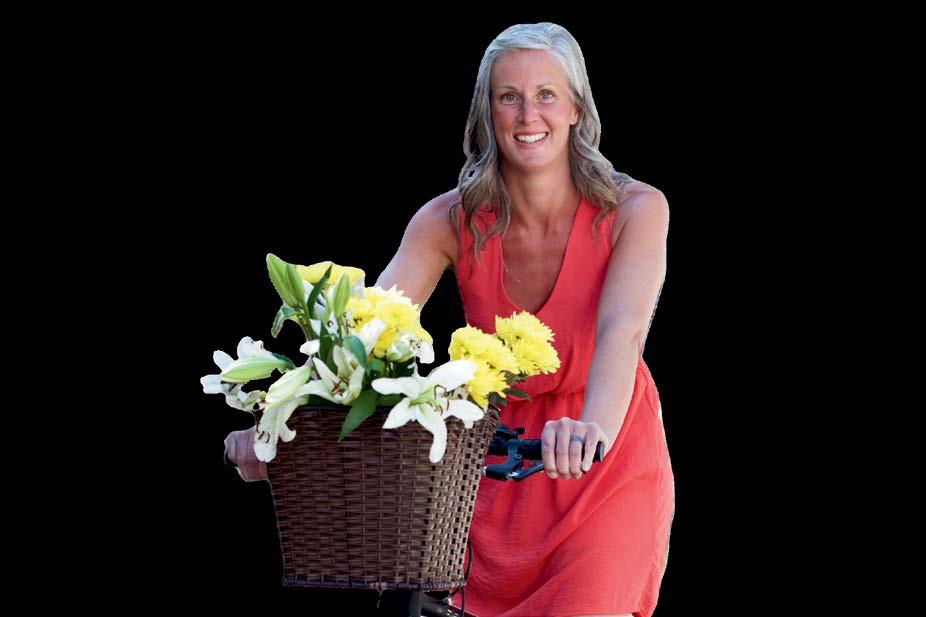





By Sylvie Chartrand
Here is a summary of some of the books I have read so far this year, in order of when I read them, not by favorites. I mostly like mystery novels but hopefully you can find something that appeals to you in the book reviews below.
Surviving Savannah by Patti Callahan
Patti Callahan is a New York Times bestselling author of both novels and short stories. She is the recipient of the Harper Lee Award for Distinguished Writer of the Year, the Alabama Library Association Fiction Award and The Christy Award for Book of the Year.
June 1838, The Pulaski steamship sunk, taking many people down with her, including a family of 11. When the wreck is discovered 180 years later, Savannah history professor Everly Winthrop is asked to curate the artifacts. Winthrop tries to piece together what happened that fateful night and is intrigued to find out how many people survived. The author of this book tells the story of a fictitious family inspired by the real family of Mr. Gazaway Bugg Lamar, who was a financier, banker, shipper and much more. He was also one of the original founders of the Savannah and Charleston Steam Packet Company
Every Last Fear by Alex Finlay
Alex Finlay is the pseudonym of an author who lives in Washington, D.C. It was on a trip to Tulum, Mexico, that Alex was inspired to write Every Last Fear.
This book will keep you guessing until the end. This is the story of the Pine family. Matt Pine, a student at NYU, received the terrible news that his mother, father, sister, and little brother all died from an apparent gas leak while vacationing in Tulum, Mexico. Sarah Keller, an FBI agent, is put on the case. Could there be a link to Matt’s other brother, Danny, who is incarcerated for killing his girlfriend but always maintained he was innocent? Maggie, Matt’s sister, and their father Evan never gave up trying to exonerate Danny. Maggie
had uncovered a clue that led them to Tulum. Was the family a threat or was it a simple accident?
Too Good to be True by Carola Lovering
Carola Lovering is the author of Tell me Lies, and her work has appeared in New York magazine, W, National Geographic, Outside, and Yoga Journal, among other publications. She graduated from Colorado College and lives in Connecticut with her family.
Skye Starling is beautiful, smart, and rich but has battled with OCD since her mother died when she was twelve. Her love life suffered because of it until Burke Michaels, older and charismatic, showed interest in her. Soon they are planning a wedding but what Skye doesn’t know is that Burke is already married with children, and this is all a plan to rob her of her money.
This is a twisted story of love and greed. The ending will probably surprise you.
Ball Park by John Farrow
John Farrow is the pseudonym of Trevor Ferguson, a Canadian novelist and playwright with six previous novels in the Emile Cinq-Mars thriller series and seven literary novels under his own name. Booklist in New York has called his crime series the best of our time. Die Zeit in Germany has called it the best of all time.
Montreal, 1975. Quinn Tanner, a seventeen-year-old thief, chose the wrong house to rob. When she goes back to her get-away car, she finds her driver dead.
This case lands in Detective Emile Cinq-Mars’s lap on his first day shift after being transferred from the Night Patrol, who are known for their toughness. He is partnered with Yves Giroux, another ex-Night Patrol detective some say isn’t on the “up and up”. A simple robbery turns into a clash with the mafia.
These books and so many more are available at the Ottawa Public Library!
Sylvie Chartrand is a public service assistant at the Sunnyside Branch of the Ottawa Public Library.

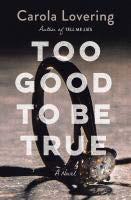

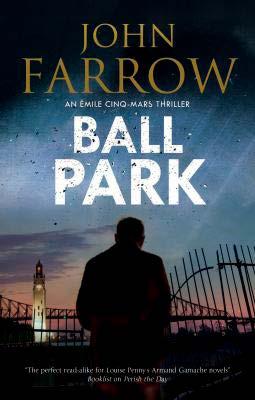






By Jillian Wright
Be a part of the excitement from August 16 to 18 as Odyssey Theatre stages a totally unique experience: Myth, Legends and True Stories, a creative arts fair. Odyssey is bringing together an explosion of diverse performances and hands-on arts workshops and crafts to explore the world of myth and folklore along the Rideau River in beautiful Strathcona Park.
Since 1986, Odyssey Theatre has produced award-winning professional theatre productions featuring masks, movement, elaborate sets and costumes, puppets and music that transform the park into a magical Theatre Under the Stars.
One notable performance to look forward to at this year’s fair is entitled Heart’s Desire: Mythical Masked Theatre by Odyssey’s Young Company. It is an original, 40-minute, environmentally staged play, a captivating, masked theatre that will take you on a mythical adventure through different cultures with dynamic mask and puppet work. Heart’s Desire is under the direction of theatre artist and Glebe resident, Eleanor Crowder.
Crowder is a core collective member of Bear & Co., a clever and witty theatre company in Ottawa that offers work from the Elizabethan era to the present day. Crowder is also Odyssey’s artistic associate, youth training. Along with other Odyssey artists, Crowder guides aspiring theatre artists through a professional theatre company experience






through Odyssey’s apprenticeship program that allows young people to explore and expand their artistic interests, develop their skills and prepare for a possible career in the arts.
This summer, audiences can go behind the scenes with a workshop performance of a new play based on the folktale The Handless Maiden. Odyssey’s young company will lead audiences throughout the park as they bring to life mythical creatures.
The park will also be animated by lively dance performances and storytelling by artists from a variety of cultural traditions. Audiences can venture on a mythical scavenger hunt or participate in hands-on workshops led by professional artists in mask and puppet creation, crafts and more.
Odyssey is well known for featuring masks, movement and puppets, so why the change this year? “We want to bring artists working in a variety of art forms, together with youth and curious audiences, to share and experience the powerful stories that shape our communities and influence the way we each live,” says Laurie Steven, Odyssey’s artistic director.
Performances are free – you can pay what you wish. Some events, like the puppet creation workshop, will have limited space and require registration. The schedule and full list of artists and events is on Odyssey’s website at www. odysseytheatre.ca.
Jillian Wright is a marketing consultant with Odyssey Theatre this summer.









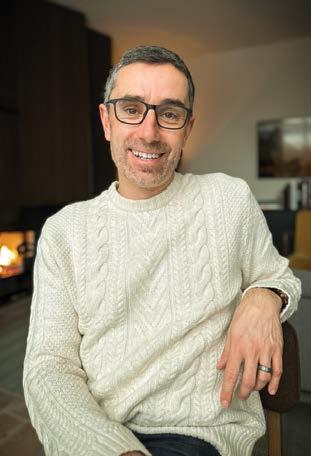



TV show (UK, 2024)
Produced by Kathleen
Jordan
Review by Iva Apostolova
I was beyond happy when Netflix announced the July release of Season 1 of TV writer and producer Kathleen Jordon’s The Decameron. My joy had at least a couple of roots. It woke me up from the movies’ summertime slumber. And it made me madly cheer for an attempt to, finally, adapt, in every sense of the word, a classical piece of literature that no one except English Lit majors reads any more.
The Decameron , which literally means “ten-day” in Greek, is a medieval piece of prose written circa 1350 by the Italian writer Giovanni Bocaccio. The original contains 100 stories told over a period of ten days by a group of seven women and three men while hiding out from the Black Death (i.e., the bubonic plague) in a villa outside Florence. Boccacio’s masterpiece is a classic for many reasons, one of them being that it served as the foundation for Geoffrey Chaucer’s Canterbury Tales (one of the most significant literary pieces of Middle English written circa 1400). Without getting lost in the historical quagmire, there are a couple of things worth mentioning here. Just like Canterbury Tales is of great importance

for the development of the English language the way we know it today, The Decameron was dubbed “The Human Comedy” as an allusion to Dante’s Divine Comedy for both its satirical content and its Florentine vernacular, which later served as the basis of modern Italian.
Both The Decameron and Canterbury Tales are some of the first complete and authored pieces of smut literature, if you will, full of practical jokes and stories that challenge the social norms of human sexuality, in which sense they were both ahead of their times. The tales in both range from crudely erotic to pure Sophoclean tragic. And last but not least, The Decameron has always been considered by historians a rich testimonial tapestry of life in Europe during the bubonic plague which, in the span of seven years, killed about
La Chimera (Italy, 2023)
Director: Alice Rohrwacher
Review by Alexa MacKie
While basking in luscious landscapes and the tantalizing warmth of a summer’s day, it’s as if for a moment time stands still.
In the 1980s Tuscany of Alice Rohrwacher’s La Chimera , the setting evokes a specific timelessness where past, present and future can co-exist.
And so they do, albeit disastrously, for Arthur (Josh O’Connor), an English archaeologist who returns to Italy fresh out of prison for grave robbing. Arthur quickly reunites with his tombaroli, or “tomb raiders,” who eagerly welcome back his talent. With the help of a divining rod, Arthur experiences visions which tell him exactly where to dig to find tomb treasures that they later sell to Spartaco (Alba Rohrwacher), an elusive art dealer.
But Arthur, brilliantly portrayed by a sunken-faced O’Connor in a scuffed off-white suit, is deeply uninterested in the loot. His mind and dreams are haunted by his lost lover Beniamina (a
mystifying Yile Vianello), forever tied to Arthur by a real and metaphorical red thread.
Beniamina is the Eurydice to Arthur’s Orpheus – an aching reminder of everything he lost and loved and the cause of his immovable pain. Similar to the Greek myth, La Chimera kindles a tragic story with layers of beauty in both the artistic and natural worlds.
Rohrwacher’s script balances adventure, magical realism and specks of drama, with clues to Arthur’s past scattered just out of reach. We never learn exactly what happened to Beniamina. We also never fully understand Arthur’s motives nor the source of his abilities. However, La Chimera is less interested in the details of Arthur’s past, opting to focus on how his past lays the consequences for his present and future.
As Arthur burrows further underground and sifts through the darkened tombs, captured with eeriness by cinematographer Hélène Louvart, we learn that Arthur’s grave robbing is a metaphor for his inability to move on. And so his actions reflect not a fascination with the objects he finds but rather an obsession with clinging to what he lost.
LET THRIFTING FOR YOUR KIDS BE EASIER
Shop online at fabrickcollective.ca or visit our family-friendly shop at 70b Beech St in Little Italy (open Tues-Thurs 10-5, Fri 12-5, Sat 10-5).
Pick-up, local delivery + flat-rate Canada-wide shipping available.
We stock quality preowned clothing in sizes newborn to youth 16, outerwear, shoes, outerwear, toys, books + baby gear. Every item has been donated and proceeds support the Elizabeth Fry Society of Ottawa.

50 per cent of Europe’s population. I liked Jordon’s artistic choices opting for coherence of the storyline, choosing only a couple of parallel stories that always end up crisscrossing their threads, as opposed to mobilizing the shock factor and relying on the many allegories omnipresent in the original. You have your evil spinster and her soft-hearted queer handmaiden, the handsome physician, the rich dupe, the savvy and woke estate keeper with strong inclinations toward social justice, the pious wife and her very gay husband, and finally, the two sisters who switch places. What can possibly go wrong with such a motley crew?
And unlike the 1971 Pier Paolo Pasolini’s Decameron which, more or less, uses only the framework of the original to sharpy criticize Pasolini’s contemporary social reality, including its
deeply seated homophobia, Jordon’s adaption remains more faithful to Bocaccio’s work. It starts out as a hilarious comedy to finish on a somewhat sentimental note of the inevitably tragic human condition. Where Pasolini borrows and essentially weaponizes the full gamut of medieval scatology (for obvious reasons) scattered throughout the original work, the Netflix show has a milder taste, hallmarked by the deadpan signature British comedy put into motion by the acting chops of Tanya Reynolds (whom the viewer might know from Sex Education) and Douggie McMeekin (Catherine Called Birdie), thus making its accessibility and good fun its charm. The viewer will also be pleasantly surprised that Jordan has modernized The Decameron in a way that many other period dramas of late (Bridgerton and Mr. Malcolm’s List are notable examples) have successfully done by diversifying the acting cast –Amar Chadha-Patel, Karan Gill and Jessica Plummer offer exquisite colour-ful interpretations of their respective characters.
Netflix original
Season 1, 10 episodes
Running time per episode: 60 mins.
Iva Apostolova is associate professor and vice-rector, research and academic at Saint Paul University and a regular Glebe Report contributor on films and TV.

Such obsession is magically accentuated through examining Etruscan history. The tombaroli uncover ancient artifacts, including a statue of Artume, the Etruscan goddess of animals and nature. The value of the treasures is highlighted as La Chimera weaves in themes of capitalism and materialism: Spartaco auctions off the priceless artefacts to the highest bidders on a luxury boat, showing little care beyond the dollar value of the piece at hand.
In striking that harmony between art and consumerism, Rohrwacher elevates the value of the treasures’ natural beauty, ensuring that we too are just as obsessed with the grave robbing as the tombaroli.
Also accentuating that obsession, Arthur stays with Beniamina’s mother, Flora (Isabella Rossellini), who equally refuses to accept that her daughter may never return. Rossellini’s sympathetic portrayal evokes sprinkles of sorrow with motherly affection, and Flora’s attachment to the past is less of an obsession akin to Arthur’s and more a tragic aura of deniability.
Perhaps the only character who stays in the present, Flora’s live-in student, Italia (an enchanting Carol Duarte), is a breath of refreshing novelty. At one point, Italia turns an abandoned train station into a colour-plenty home for
her family. The transformation contrasts to the purposefully dwindling grandeur of Flora’s home, decked in greys and beige despite the heavenly rays of sunlight which slip between the surrounding trees.
The flirtatious glances between Arthur and Italia are fleeting but rife with a delicate charm. However, Arthur still can’t nurture their romantic spark, despite the future Italia cements. Duarte brings lightness with warming determination to her character, to the extent where we too feel Arthur’s loss.
That stubbornness to move on, so elegantly portrayed, is what makes La Chimera such an ethereal depiction of romantic and personal deprivation. Coupled with the questions it never quite answers, the film evokes both magic and truth – magic in the tombaroli’s treasure-hunting endeavours and truth to Arthur’s destructive despair.
Running time: 2 hours 10 mins
Rated: PG
Available to rent Apple TV, YouTube and Amazon Prime.
Alexa MacKie is a Carleton student in Journalism and Law, a communications officer and a Glebe Collegiate graduate.
By Eileen Durand
In a world increasingly dominated by digital interactions and fleeting moments, the enduring significance of art stands as a testament to the human spirit. By attending art shows, we not only celebrate our capacity for beauty and innovation but also ensure that the arts continue to thrive for future generations.
This year, the Glebe Fine Art Show will be held on the weekend of September 14 and 15. It will provide visitors an opportunity to engage with and support the arts by attending this most awaited art show of the year.
Through a variety of media including fine artworks using oils, acrylics and watercolours along with mixed media, pastel, embroidery and fine art photography prints, artists capture emotions, provoke thought and offer new perspectives.
The show will bring together 34 juried artists, including four new ones to the event. See the full list of artists at: www.glebefineartshow.ca.
Here are a few reasons why it is important to make art shows a priority:
Cultural Enrichment: Art shows offer a rich tapestry of cultural expressions. By attending, you immerse yourself in a world of creativity and innovation, gaining insights into different cultures, histories, and viewpoints.
Support for Artists: Artists dedicate their lives to creating works that inspire and challenge us. By attending art shows, you support these creators, providing them with the recognition


and financial stability they need to continue their work.
Community Engagement: Art shows bring people together. They serve as a hub for discussion, collaboration, and community building. Engaging with art in a communal setting fosters connections and conversations that might not happen otherwise.
Personal Growth: Exposure to art can lead to personal growth and self-reflection. Art invites us to explore our emotions, confront our biases, and expand our understanding of the world around us.
Inspiration and Innovation: Art stimulates creativity and innovation.
Whether you are an artist, a professional in another field, or simply an art enthusiast, the ideas and emotions sparked by art can influence your work and personal life in unexpected and meaningful ways.
Join us in supporting the arts and experiencing the profound impact of art by attending this upcoming art show.
An open café (Mato’s Café) will be offering delicacies, light lunches and beverages throughout the show hours. Free admission and door prizes will provide additional incentives to visit.
Eileen Durand is a long-time resident of the Glebe and an art lover for many years. She is also the co-coordinator of the Glebe Fine Art Show.
Glebe Fine Art Show
Saturday, September 14 & Sunday, September 15, 2024
10 a.m.–4 p.m.
Glebe Community Centre 175 Third Avenue
Free admission & door prizes www.glebefineartshow.ca



By Louise Rachlis
To help celebrate its “100 years of courage and caring” this year, the Federation of Medical Women of Canada (FMWC) asked women in medicine to help them design a commemorative scarf that represents or symbolizes the accomplishments of the FMWC over the past century.
The contest winner was Glebe resident, artist and retired family physician Janet Dollin.
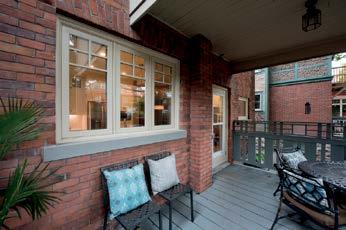
The theme for the scarf was “catalysts for change: celebrating 100 years of women in medicine, past/present/future.” The image was to be symbolic or representative, abstract or realistic. The scarf was to be printed on modal silk as a wrap or scarf, 26” x 80.” Anonymous judging for the contest was based on wearability, creativity and meaningfulness.


Dollin’s winning entry was “From Seed to Flower: a celebration of 100 years of Women in Medicine.” It was a multimedia piece in acrylic on canvas with digital layers.
In her artist’s statement, Dollin wrote: “Just as the flower grows from its seed, the seed that the flower produces brings about the future in an infinite cycle. These beautiful six founders of the Federation of Medical Women of Canada, who are represented here as flowers, had a 360-degree view, looking forward and also back. Through both reflection on the past and planning for the future, they seeded a cycle of growth from past to present to future. The colors are bold. We celebrate 100 years as the voice of bold and powerful medical women. The caduceus, serpent and wing of FMWC’s logo is symbolic of our healing power when we work together.”

Dollin feels she is “now learning the healing power of colour” and is honoured to win this contest and to wrap herself in their colourful centennial scarf. “I paint because
it is my own mindfulness practice,” she adds. “Proceeds or paintings themselves are often donated to charities near and dear to me.”
The scarf with her design is a fundraiser for the FMWC. It will be available for purchase on its website; the email is fmwcmain@fmwc.ca. The federation will hold its centennial meeting, for which the contest was held, in Ottawa in September.
Dollin is also proud to have wonderful Glebe neighbours who have her paintings and mosaics in their homes and gardens. Her own website is www.janetdollin.com.
By Andrea Tomkins
Ottawa’s music scene is set to hit a high note this October with the fourth annual Ottawa Blues for Youth. This fundraiser, championed by long-time Glebe resident Anita Manley, has become a hallmark event in our community. The main event will take place at Irene’s Pub on Saturday, October 19, and for the first time ever, the celebration will extend into an all-ages after-party on Sunday, October 20.
This event is more than just a musical gathering, it’s also a powerful initiative dedicated to youth suicide prevention through the Youth Nominated Support Team (YNST) in partnership with Pleo and The Royal. Manley, who has deep ties to The Royal and an unwavering commitment to mental health advocacy, has been the driving force behind Ottawa Blues for Youth. Her dedication stems from a personal connection to the cause, and her efforts have not gone unnoticed. This year, Ottawa Blues for Youth was the recipient of the Best Fundraising Event award from Faces Magazine
A night to remember
Whether you’re a long-time fan of the blues or simply looking for a way to support a worthy cause, Ottawa Blues for Youth offers something for everyone.
This year’s event will feature performances from some of Ottawa’s best blues musicians including Murray Kinsley & Wicked Grin, an Ottawabased roots blues/rock band with gritty vocals and guitar and an “in-your-face” groove that doesn’t quit, and The Angelique Francis Band. JUNO award-winning artist Angelique Francis is a versatile and exceptionally gifted musician. This talented, multi-instrumentalist, multi-genre, singer-songwriter and composer has wowed audiences across the globe with her electrifying performances, instrumental abilities and powerful, textured vocals.
The all-ages after party on Sunday featuring KJ and the Strayways promises to be an extension of the joy and camaraderie experienced the night before.
Expect soulful tunes, heartfelt lyrics and an ambiance that captures the spirit of the blues.
The cause behind the chords
Since its inception, Ottawa Blues for Youth has supported at risk youth in our community. Funds raised from this year’s event will support YNST, a suicide prevention program designed to improve outcomes for young people who have recently reported a suicide attempt or have serious thoughts of suicide.
To date, Ottawa Blues for Youth has raised over $79,000. “It’s a testament to the generosity and compassion of our community,” says Manley. “Each dollar we raise makes a difference.”
Manley’s vision for Ottawa Blues for Youth extends beyond raising money. It’s about fostering a sense of community, raising awareness about mental health and breaking down the stigmas that often accompany it.
The success of Ottawa Blues for Youth wouldn’t be possible without the support of local businesses, volunteers, and, of course, the attendees. Manley sends a special shout out to emcee

as to Irene’s Pub.
“Irene’s Pub has been an unwavering supporter, providing the perfect venue for this annual fundraiser which is catching youth and saving lives,” says Manley. “And of course we can’t forget our musicians! They enthusiastically provide their time and talent, creating an unforgettable experience for everyone involved.”
Visit the Ottawa Blues for Youth website for more information on how to buy tickets or contribute to the cause in other ways, such as the silent auction. For those who purchase tickets, there will be a live auction on Saturday night, and both events will have door prizes and giveaways.
In the words of Manley: “Music has the power to heal, to bring people together and to create lasting change. Ottawa Blues for Youth is more than an event, it’s a movement. Join us, and let’s make this year’s event the best one yet. Together, we can support the mental health of our youth and ensure they have the bright future they deserve.”
Don’t miss out on this opportunity to enjoy great music, connect with your community, and support a cause that truly matters. Tickets went on sale August 8. They do sell out so grab ’em while you can.
For more information and to buy tickets, go to ottawabluesforyouth.com.
Andrea Tomkins is a writer at the Royal Mental Health Centre.
By Janice Manchee
Rideau Chorale is growing again, and we’re on the lookout for new voices.
Rideau Chorale is a 60-member, auditioned choir housed out of Southminster Church in Old Ottawa South. Its members come from across the National Capital Region.
The choir’s mission is the musical development of its members, the pursuit of artistic excellence and the presentation of beautiful music to the community. In line with that first goal, the choir offers its members regular workshops on choral skills, such as sight-singing and breath control.
Like most choirs, Rideau Chorale is always looking for tenors and basses but welcome alto and soprano applicants as well. If you or someone you know is looking to raise their voice in song, think about Rideau Chorale’s upcoming auditions, to be held Thursday, September 5 and Saturday, September 7. For more information or to book a space, contact info@rideauchorale.com.
Information about Rideau Chorale can be found at rideauchorale.com.
Janice Manchee sings tenor with Rideau Chorale.
Bytown
By Mary Forster
Happy members return again and again to the Bytown Voices, though not always in the perfect proportion. To try to balance our sound this term, we’re making a special request for tenor and bass voices. We need you! We’re also interested in younger members since we’ve opened to youth aged 9 (Grade 4) and up. If you’re the parent of a young singer, consider joining along with your child. Members benefit from many online learning resources offered in a supportive environment. You’ll learn a lot and leave practices knowing you’re gaining skills while sharing in a beautiful challenge with others.
Bytown has a “no audition necessary” policy with an SATB (soprano, alto, bass, tenor) format. We operate under the artistic directorship of Joan Fearnley who has led the choir since 2015. She brought with her years of experience conducting both the women’s and children’s choirs of Notre Dame Basilica. Fearnley has also had a noted career as a soprano soloist whose years of voice study informs her teaching.
Fall term begins on Tuesday, September 10. Practices are held at 7:30 p.m. at St Basil’s Church on Maitland just north of the Queensway. Registration is now open online through the website www.bytownvoices.com. Check out the website to learn more about us and the music we sing.
Mary Forster has sung with Bytown Voices for five years.


By Nadine Dawson
Bear with me, it’s not really a non sequitur, but . . . Remember when you were expecting your first child? That time in your life when you are completely consumed by What to Expect When You’re Expecting, along with such important decisions as midwife or obstetrician, home birth or hospital? Remember how you walked around town glowing with Expectation?
Soon enough, your little bundle of joy arrives in the world, and you are thrilled! Welcome, little one, welcome, you cry! And then Junior does cry, and you realize you have absolutely no idea how to care for an infant. It occurs to you that maybe this parenting thing is going to be a bit more complicated than you first thought.
Fast forward a few years, and you are ready to retire. Hooray! You’ve taken the course about pensions and old age security, and you’ve crunched the numbers. You’ve made important decisions such as June or September, cruise or safari? And you walk through your days glowing with Pending Emancipation.
Soon enough, your last day arrives. You say your farewells, pocket your gold watch (or in my case, a handbell?!?) and step out into Freedom. That’s it, you cry, I’m retired! But then a little voice whispers, now what? And it occurs to you that maybe this retirement thing is going to be a bit more complicated than you first thought.
The truth is, just like parenting, retirement can test our mettle.
Statistics will tell you that many people’s happiness actually decreases during the first two years of retirement. Research shows that many retirees end up spending too much time with their new best friends – the couch, the TV and the fridge. And if by retiring younger than your peers or in poor health or from a workaholic job, and if you find that your social
Let Abbotsford Seniors Centre help you to distill what retirement might mean for you. A Workshop of Discovery for the Newly, or Nearly, Retired will be held October 16.
contacts, like your finances, are tighter than expected or that the hours in the day are longer than expected, quite unexpectedly you may find yourself drifting –bored and lonely and decidedly unhappy.

Before you give up on retirement and scurry back into the workforce, consider this: with a little knowledge, a little patience and a few well-placed resources, you too can retire happy, wild and free!
Yes, yes, you exclaim. That is exactly what I want!
Good news! An interactive, one-day workshop is coming your way.
The goal is to bring together new retirees to discuss
what it means to make the transition into retirement, explore ways in which we might reinvent ourselves for our new role and consider how we might structure our time to better serve our happiness and satisfaction. Additionally, we will consider ways to make meaningful connections in the community so that we remain vital, contributing members of society.
How did this workshop come about, you ask? My former colleague Kathy Bol and I have sampled the panoply of emotions that retirement has to offer – from the early confidence of thinking we got this to the dawning realization that January in Ottawa is dark and cold and long when you’ve no particular place to be. Thus began a search to discover how to be more happily retired. Now, collectively, we can speak personally about parttime work and volunteer work, physical activity and routine, creativity and identity and travel and play. As retired teachers, not only do we still love to learn, we also still love to share what we learn, so we created a workshop for people to meet, exchange ideas and move forward in retirement with greater awareness.
So, if you want to make the most of your retirement but are not exactly sure how to do that, or if you would like to connect and share experiences with other newly, or nearly, retired people, please join us for the day on Wednesday, October 16. We can’t guarantee you will have a long and meaningful retirement – but we can help you orient yourself towards one.
For further inquiries or to register, look for the Fall Program Guide for Abbotsford Seniors Centre, (the old stone house at 950 Bank Street) or contact them at 613230-5730 or abbotsford@glebecentre.ca.
Nadine Dawson is an artist of fickle loyalties who lives in Old Ottawa South. She is the almost completely unknown author of Lavender, Longing, Love; A Choose-Your-Own-Adventure Memoir. Nadine is also a member and volunteer at Abbotsford Seniors Centre.








Canada’s
Yasir Naqvi
MP, Ottawa Centre
N 613-946-8682
E yasir.naqvi@parl.gc.ca
Summer is in full swing, with many events big and small in our community! I hope you have had the chance to enjoy the Jazzfest, Bluesfest, Lebanese and Greek festivals and many other neighbourhood activities. These have been amazing opportunities for me to connect with so many of you.
In my conversations with constituents, I sense real anxiety about jobs, wages, mortgages, rent and food prices. It is totally understandable as we know that the global economic uncertainty is caused by the pandemic and exacerbated by conflicts in Ukraine and the Middle East. These events have a direct impact on our lives.
As we recover from the pandemic, the cost of housing has skyrocketed, making the dream of owning a home more elusive for younger Canadians and the economically disadvantaged. In terms of everyday life, the cost of purchasing essential goods – everything from fuel to groceries – rose dramatically. Inflation hit 8.1 per cent midway through 2022, and household debt in Canada continues to surpass the G7 average of 125 per cent related to the disposable income households can access. The corresponding rise in interest rates to combat inflation increased the challenges for those seeking financing or renewing their mortgages.
The good news is that the Canadian economy is outperforming expectations. In the face of higher interest
rates, Canada has avoided the recession that some had predicted. Inflation has fallen from its June 2022 peak of 8.1 per cent to 2.7 per cent in July 2024. As such, the Bank of Canada has lowered the interest rate from five per cent to 4.75 per cent, making Canada the first G7 country to initiate a rate cut.
The labour market remains solid. Over 1.1 million more Canadians are employed today than before the pandemic, marking the fastest jobs recovery in the G7. Real wages (that is, wages adjusted for inflation) have gone up, meaning Canadians, on average, have more purchasing power.
Private sector forecasters expect the year ahead should bring further progress. By the end of the year, they expect economic growth will pick up, interest rates will be lower and inflation will decline to about two per cent. Both the International Monetary Fund (IMF) and the Organisation for Economic Co-operation and Development (OECD) project that Canada will see the strongest economic growth in the G7 in 2025.
But there’s more to do. Through Budget 2024, the federal government is making significant investments in health care, early learning and childcare, better integration of newcomers, boosting housing supply and fostering historic investments for the net-zero transition. These investments ensure people are healthy and able to contribute to their full potential in the labour force. For instance, affordable childcare has helped women in their prime working years to reach a record high employment rate of 85.7 per cent in September 2023, compared to just 77.4 per cent in the United States!
All in all, Canada’s economic fundamentals are strong. However, we need to ensure the economy works for you, with a good job, higher pay, and more money in your pocket. That is the important work ahead of us, and as your MP it is my focus.




MPP, Ottawa Centre N 613-722-6414 E JHarden-CO@ndp.on.ca
Jelly Roll, the popular singer, rapper and composer from Tennessee, came to Ottawa for Bluesfest last month and made quite the impression.
Jelly has a powerful story to tell. It is a story of struggle and compassion for those struggling with addiction. A story of families torn apart from the poisoned illicit drug supply that is killing people.
Jelly struggled with drug addiction, and his family struggled too. He once thought selling drugs was a victimless crime, so he mixed chemicals for profit.
He doesn’t believe that anymore. Now he is sounding the alarm about the dangers of street fentanyl, a drug normally prescribed by doctors for severe pain in hospitals. He has been to countless funerals. He wants the tragedies to stop.
Jelly has reached out to those trying to heal and to others trying to help them. He recently testified to a U.S. Senate Committee to humanize the plight of those caught in cycles of addiction and deteriorating mental health.
Prior to taking the Bluesfest stage, Jelly performed at the Royal Ottawa Hospital for a rapt audience of patients and staff. One of the songs was “I am not okay,” a stirring, honest reflection on struggles with mental health.
I am not okay
I’m barely getting by I’m losing track of days
And losing sleep at night
I am not okay
I’m hanging on the rails
So if I say I’m fine
Just know I learned to hide it well
I know, I can’t be the only one
Who’s holding on for dear life
But God knows, I know
When it’s all said and done
I’m not okay
But it’s all gonna be alright
It’s not okay
But we’re all gonna be alright
And yet it’s worth thinking about how we’re gonna be alright. Overdose experts tell me that progress doesn’t happen by accident; we need investments in services, staff and supports that can help people. But not enough of that is happening.
For example, the Somerset West Community Health Centre’s Drug Overdose, Prevention and Education (or DOPE) program is closing. The DOPE program had over 31,000 interactions since its founding in 2019 with neighbours who use drugs, hiring outreach workers who were once users themselves. This was working.
I recently watched the film Love in the Time of Fentanyl that detailed the work of grassroots harm reduction activists in Vancouver’s Downtown East Side. I met with Ronnie Grigg, the founder and executive director of Zero Block Society who is featured in the film. Ronnie said we are losing the battle as we fail to make the right investments. And that’s where I’ll disagree with Jelly Roll. In his recent presentation to the U.S. Senate Committee, he got behind a bill with a criminal justice approach to the overdose crisis, focusing on fentanyl traffickers and using financial sanctions to raise funds for law enforcement. But a criminal justice approach hasn’t worked.
What’s working is support for neighbours suffering with mental health and addictions issues. That is what Jelly Roll offered in his visit to Ottawa, and it is what mental health leaders and harm reduction workers do every day. Bless them all.
I want to live in a society where mental health matters as much as cancer care, where a broken heart matters as much as a broken leg.
We’ll get there with compassionate public policy.

By Charles Weiner
In 42 years as a structural repair expert, I have seen periods of high inflation and recession come and go, and there is one common denominator that they all share. Simply, they are times when thieves, swindlers and con men come out to reap the profits from your home improvement projects. This happens especially in my area of expertise, which is foundation and brick repair. Beware of those who are experts at exploiting your good intentions with cordial talk, fake references and even lengthy guarantees that, if you do the calculations, last longer than that individual will exist on this planet.
This is no joke, people! Repeatedly, unsuspecting homeowners fall for the money grab. Swindlers offer you, above all else, a price too good to be true. So, how do they manage to pocket your money?
The most common method, of course, is to run off with your hefty deposit. The problem is, customers are becoming wise to this maneuver. So, the con
man, ever resourceful, might change the game plan and complete “part” of the job before payment.
You may ask, what is the problem with that? The job, after all, is being done. This is where experience and knowledge come to play. In the foundation repair profession, it is very simple to cut costs. Most of this is done on materials and faking the repair.
Let’s use an example of the typical Glebe rubble foundation. This is a poured concrete foundation, often over a hundred years old. When the walls begin to rot from the outside, a small electric scaling machine is used to remove the compromised material, ensuring all degraded areas are thoroughly extracted. A contractor, if dishonest, could simply use a gentler touch and skim over the exposed foundation.
The second step is to set up wooden forms and pour a concrete-rich skin over the exterior repair area. I use a polymer flow cement which is a superior product and guarantees that the cement bonds and flows into all
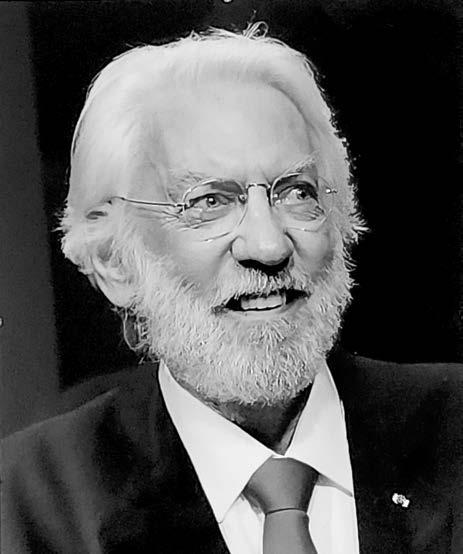
By Bob Irvine
Over the years, I had two face-to-face encounters with Donald Sutherland. Both were brief but also very pleasant. First some background.
My wife, Karen, and I try to get down whenever we can to our summer cottage on the east side of Lake Memphremagog in Quebec’s Eastern Townships. The lake is 50 km long, running from Newport, Vermont in the south to the city of Magog, Quebec at its north end. Magog is seven km north of our cottage. The town is a bustling tourist centre with a population of 30,000. Eight km to our south – also on our side of the lake –is the village of Georgeville. The town, which has a population just in the hundreds, is a pretty piece of old-time New England that happens to be in Quebec. Founded in 1797, Georgeville has two stately churches,
areas behind the form. Others might use regular cement that costs a quarter of the price. Other proper materials can cost upwards of 10 times the price of what these people use. Of course, the cheap materials do not prevent the walls from degrading further. But for a short period until backfill, they look great!
There are no deals when it comes to repairing the structure of your home. Thieves come in two forms. Those that charge way too much and those that charge too little. Right now, when people are counting their pennies, the second kind has taken the stage.
I cannot, and will never, understand how people fall for this charade. No matter how much I explain that they are being fooled, they do not believe me. The price is too good. The promises and cordial smiles are too mesmerizing. Their contracts are finely detailed and come in professional brochure covers. Beautiful pictures of their work displayed in advertisements add the “piece de resistance” that cannot be doubted. I don’t blame anyone.
a village square, Greek Revival-style white houses and a schoolhouse converted into a place for meetings: Murray Hall. Just at the south end of the village lies Dunkeld, a large mansion and ample grounds, established for a Montreal business magnate in the 1800s and now owned by the Sutherlands. Among the various places where he and his family would live, Donald Sutherland would call Georgeville his “emotional home.”
Now back to my interactions with Donald. (Everyone in Georgeville called him by his first name.) The first time I met Donald was in the early 1980s. Donald and I and our wives had both just finished with cashiers at a supermarket in Magog. In an age before selfies and texts, I asked Donald if he could kindly write an autograph for my niece, Heather, in Victoria, B.C. Karen found a blank envelope. With a broad smile and taking his time, Donald wrote a personalized note to Heather. I thanked Donald profusely, and we went our separate ways.
The next time I met Donald was in 2005. It was just after the release of a new movie, Pride and Prejudice, in which Donald had starred. Donald, who was passionate about the health of Lake Memphremagog, was attending an update in Georgeville by a watchdog group on the state of the lake. I and many others were also there. Karen was playing bridge with girlfriends.
After the meeting ended, I noticed that Donald was standing alone. I approached him. I instantly started gushing about how great he was in the movie. Here was our exchange:
Irvine: I wanted to say that my wife and I feel you absolutely hit it out of the park as Mr. Bennet. We loved how, as the gentle patriarch, you kept a steady hand on the tiller as you and Mrs. Bennet cared for your five highly marriageable daughters.
Sutherland: Thank you. You’re kind. [Donald pauses, then leans closer as if he’s about to share

Without knowledge of the repair process, it’s almost impossible to tell a quality job from an inferior one. Or is it? In fact, it is possible! I tell all potential clients to please get the advice of a qualified structural engineer, so they know and understand the parameters of the job at hand. Unfortunately, many do not bother and throw caution to the wind. If you want to know the correct way to repair your foundation or structural supports, like joist and beams, contact a structural expert.
Charles Weiner can be reached at 613915-8377 or Charleszave65@gmail.com. “My analysis will stand against the scrutiny of any structural engineer.”
a bigtime showbiz secret.] You know, we needed to make two different endings to the movie: one for audiences in the U.S. and Canada and another for the rest of the world.
Irvine: Oh!
Sutherland: Yeah, at the end of the movie, we knew that the rest of the world would instantly recognize that Elizabeth and Mr. Darcy were deeply in love and would soon marry. But, especially for American audiences, we needed to make it totally explicit – a sort of paint-by-numbers – that clearly showed that the couple had really hit if off and would build a life together.
I would later check: the Pride and Prejudice of 2005, as shown in the U.S. and Canada, is six minutes longer than anywhere else in the world.
From time to time, we would see Donald and his family around Georgeville. One time, Karen and I were shopping in the village’s small general store. From the other side of the store, we could hear Donald’s trained-for-the-stage voice call out: “What a beautiful head of cauliflower! We could make a great soup with it!”
There was an annual show in July in Murray Hall that showcased the works of artists of the village and surrounding region. The show always kicked off with an evening vernissage. Donald would arrive with a big wad of American bills. He would then talk at length with every artist about their techniques and paintings. By the end of the evening, Donald had supported many of the artists by buying their works.
Donald was a man who was a master at his craft. He loved life and actively engaged with the world around him. Everyone in the village misses him.
Bob Irvine is a sometime Glebe resident and frequent contributor to the Glebe Report, especially around April 1 each year.
The following is part of a continuing series of profiles of servicemen from the Glebe and St. Matthew’s Anglican Church who gave their lives to Canada and the pursuit of peace in the Second World War. We commemorate and remember their passing, 80 years ago.



By Kevan Pipe
John Sidney Dunlevie was born in 1915, son of Frederick and Elizabeth Dunlevie. In 1930, the family moved to their new home at 34 Renfrew Avenue in the Glebe where John graduated from Glebe Collegiate circa 1934 while also attending St. Matthew’s Church.
He enlisted in the Royal Air Force in 1935 and received bomber training in both Egypt and Iraq in 1937 until being injured on duty in an air crash. John returned to England to recover and was assigned to RAF Station Hendon, Communications Squadron, until 1940.
It was during this time that he returned on leave to Ottawa and married Dorothy Short in 1939.
With the Second World War now in full swing, Pilot Dunlevie was assigned to Bomber Command in 1941 as Acting Wing Commander of RAF 107 Squadron, flying missions over Germany and France in Blenheim bombers. He was then promoted to Wing Commander/ Commanding Officer of the squadron and posted to Malta, which was under severe attack from Axis forces, as part of #2 Bomber Group, responsible for bombing German supply lines
across the Mediterranean, North Africa and Sicily.
In spring 1942, he was transferred back to Britain and sent in June to be flight instructor at New Brunswick’s Pennfield Ridge Air Station. For two years, his job was to try to alleviate the shortage of qualified pilots, training new air crew recruits as part of the British Commonwealth Air Training Plan.
Wing Commander Dunlevie returned to active flight operations in March 1944 and returned to the 107 Squadron again as Wing Commander/Commanding Officer. The squadron was now equipped with the famous Mosquito MK VI fighter bombers which focused on night operations.
On August 5, 1944, on return from a mission out of RAF Swanton Morley in Norfolk, his low-flying plane hit trees near Colliers End, Hertfordshire. The plane crashed and Dunlevie, age 28, and his flight officer, Islay MacMillan, were both killed. He was buried four days later at Brookwood Military cemetery in Surrey, England.
Wing Commander John Sydney Dunlevie of Ottawa is remembered today both at Glebe Collegiate Institute as well as St. Matthew’s Church.
Kevan Pipe is a Glebe resident and member of St. Matthew’s, The Anglican Church in The Glebe.


By Kevan Pipe
William Henry Cowling was born October 21, 1921, at Ottawa’s Grace Hospital, son of William and Lillian Cowling. He had a brother and two sisters, and the family lived at 168 Isabella Street. Willian went to Ottawa Technical School on Albert Street and attended St. Matthew’s Church.
Working as a messenger, 19-year-old William (# C37399) enlisted on March 12, 1941, in the Canadian Army Service Corps and was assigned to No. 2 Troop, 4th Armoured Division Transport Company and deployed to England in 1942.
On July 26, 1944, just 50 days after D Day, his company was deployed to Normandy in support of armoured carrier operations in the Battle of Caen, trying to prevent German troops attempting to escape the region. Just six days later, on August 1, Corporal Cowling was killed in action.
Thousands of Canadian soldiers were killed during the Battle of Caen, part of the overall Battle of Normandy. From just D Day to the end of August, 5,000 of our servicemen paid the ultimate price for eventual victory, along with tens of thousands of soldiers from our Allied forces. Never to be forgotten are the 3,000 innocent civilians of Caen who were also killed as their city was completely destroyed.
Cowling is buried at Canada’s most famous Second World War cemetery, Beny-Sur-Mer Canadian War Cemetery, located just two kilometers from Juno Beach in Normandy. He is buried alongside 2,047 fellow Canadians.
His family members were hit hard by this loss and for at least a decade after his death, they put annual memorial notices in the Ottawa Journal every August: “And while he lies in peaceful sleep, his memory we shall always keep.”
He rests there today in Normandy, France.
Kevan Pipe is a Glebe resident and member of St. Matthew’s, The Anglican Church in The Glebe.

George Bernard Shaw said that youth is the most beautiful thing in the world, a pity it has to be wasted on children. We have all been young and in that beautiful state but perhaps unable to fully appreciate it. The Glebe Report asked you to contemplate, poetically, the experience of being young – what childhood means, how memories of that time prevail. Here are your poems on being young.
Being a Kid in Kemptville in the 50s
In 1955, Mom, Dad, and me – aged five – moved to Kemptville. We would drive into Ottawa maybe once every year.
“The prices are better in Brockville,” my mother exclaimed. Every August, we’d take the ferry to Ogdensburg, To buy me new clothes for the school year. With our dollar so strong, we got many great buys.
As we walked back to the ferry for Prescott I would wear three pairs of pants inside each other, Also, three shirts, all to hide when we reached Customs.
Along the St. Lawrence River, they were building the Seaway. One sunny Saturday we went to Long Sault to see an old lock. The elderly lockmaster kindly gave me one of his logbooks. In 1927, he wrote every ship’s name that passed through his locks. Then we all backed away as men threw gas on his lockhouse. Now their boss threw a match and then all was ablaze.
The crowd clapped, cheered, and took photos, As the lockmaster – now near me – wiped away tears.
When I was nine, I went alone to the Woolworth’s in Brockville
As Dad checked out tools and Mom bought some groceries. I would buy a new record I loved but whose name I’d not heard. I went to the record shelves near the lunch counter.
To a nice teenage girl working there, I explained my dilemma. She said: “You could sing me some part and I’ll tell you its name.”
So, then with my heart in my throat, I sang: “My lover, I was wronger to try to love two ah ooha ooha ooha oo.”
All at the lunch counter stopped eating and turned quickly, To stare at the kid who just mangled a top hit of the day.
“It’s ‘Little Darlin’ by the Four Diamonds,” she kindly explained. With my saved weekly allowances, I bought my new record. When I’m gardening or cooking today, I can still hear the song.
Bob Irvine
Rocking along
Cradle/crib/stroller/tricycle/bicycle/car/bus/walker/wheelchair/rocking chair
Louise Rachlis
Ode to youth
Oh fleeting youth you were once so quick I could never catch up, now you finally see My back.
Oh lost youth your trail I’ll never find, but some Things never forgotten in my ripe old mind.
David Rockburn
The Young
You fall down and laugh

And get right up
You run and run
And never pant
You never try remembering
Someone’s name
But can’t.
Your skin is soft Your eyes are bright And being old is out of sight.
The old just dream The feats we think, When mind and body Are out of sync.
Louise Rachlis

Still

Still waking up at night?
Still eating baby food?
Still in day care?
Still in university?
Still working?
Still travelling?
Still driving?
Still waking up at night?
Louise Rachlis
I held onto childhood dreams perhaps longer than I should, afraid I would succumb to the tentacles of adulthood, holding my youth in my hands like an offering to the gods unwilling to let it go.
A whispered memory transports me back there, to the tiny house just a block from the tracks, skipping rope on the broken sidewalk with the neighborhood kids, or playing hide-and-seek and hopscotch in our dusty backyards, with Patty and June, Annie and Jo, while little Michael rode by on his bicycle. Like cherubs we played, every sunshine day, until our mothers called us in for dinner or bedtime.
While the birds chirped and the clouds hurried by, the fleeting seasons blinked and we were grown; most of us are gone now, June and Annie left this earth long ago, Patty, Jo and I moved away, only Michael still lives nearby, and I wonder if he sometimes looks out his window and sees the little girls gathered there, skipping, laughing and dreaming, and wanting to live forever in the magic of childhood play.
Louise Chivers
In these early days of my twenty-first year, I take the time to focus on the world, hoping all good fortunes won’t disappear, hoping reality will find room for a lost little girl.
Here I stand on the stairway of life, before the door of adulthood...
Am I ready for the role of mother and wife? Can leaving the rest behind really be good?
In these early days of love and romance, I stumble on my way to the first gate, something within me prevents me from taking a chance, something deeper whispers it will soon be too late.
I see the stairs that lead me into life, and all my friends have taken the final step, I try to follow but something doesn’t seem right, and my heart tells me I’m not ready yet.
In these early days of my twenty-first year, Time is already so far ahead of me, and reality only leaves me frozen in fear, as I struggle to discover who I was meant to be.
Louise Chivers
Food is a fundamental of survival. And yet it has become so much more. It can be a means of celebration, an acknowledgment of tradition or culture, a catalyst for community synergy, a tool for wielding power, a symbol of both privilege and want.
Our call for the next Poetry Quarter in November asks you to explore food in all its broad significance – from our hedonistic desire for the delicious, to the vegetarian option, to the threat of food insecurity and hunger, and beyond. We want to hear, in poetic form, your thoughts about food in all its flavours.
As usual, poems should be:
• Original and unpublished in any medium (no poems submitted elsewhere, please);
• No more than 30 lines each;
• On any aspect of the theme within the bounds of public discourse; and
• Submitted on or before Monday, October 28, 2024.
Poets in the National Capital Region of all ages welcome (school-age poets, please indicate your grade and school). Please send your entries (up to 5 poems that meet the criteria) to editor@ glebereport.ca. Remember to send us your contact information and your grade and school if you are in school.
Deadline: Monday, October 28, 2024
YOUTH - golden and fleeting
As I sit in the verandah With a cup of Coffee and The big cat on my lap.
I enjoy the fleeting sunray and sleepily watch the people going by
I see them pass by Several times a day Young people with bright sunny faces Laughing away boisterously Babbling away at each other’s joke or whatever
Walking briskly and confidently or on the bicycle speeding down the slope as if they own the road.
I too yearn to be like them and go back to my own youthful days
I would like to jump and run down the steps on to the street and walk as joyfully. But my legs say no- do not do it, I listen to their music and like to move and gyrate like them But my back refuses to budge
So, I sit and watch them and reminisce. Of my own youth gone but now forever captured in the images nicely displayed on the table and shelves I feel the warmth of youth again and fall asleep.
Faruque Sarkar
The light at the start of the tunnel cruel, to see how much one’s passage needed weeding, the tangled garden of self-sown blindness to see, too near the end and looking back, how green and sparkling the potpourri of promise really was — demanding only my own, unaffected sunshine, not glare of false priority, cheap ambition, or tabloid malice...
back isn’t it, always back to our youth, for which those sainted pens of boyhood reading bequeathed ( to me ) their magic insight:
Buchan, Stevenson and Twain, pulling me, gathering me again, now more urgently, back to ‘where the old rhymes and stories fall in kindly, soothing pastoral’
Chris McNaught
By Oscar Dennis
A long overdue city feasibility study is exploring ways to redesign Bank between the Queensway and the Canal bridge. Any changes that result from it will have implications for transit along the street as a whole and indeed could set a precedent for future changes to other sections of Bank Street.
The current design of Bank Street – generally four lanes with the two outside lanes devoted to parking except during rush hour – uses the street as a thoroughfare taking people to and from the downtown core in private cars. But Bank Street is also a designated transit corridor with major OC Transpo routes (including the 6 and 7).
OC Transpo data shows that the 6 and 7 buses are late 40 per cent of the time, and much of the street freezes before games or other large events at Lansdowne. This lack of reliability is made worse by the fact that few bus stops provide shelters or benches.
Additionally, Bank Street serves as a community space where residents go to shop, meet up with friends or have a drink. Unfortunately, being a pedestrian on Bank Street is about as pleasant as waiting for a bus on it. The sidewalks are too narrow to stop and talk, let alone for patios, and bike lanes are few and far between.
The redesign of Bank Street must make other forms of transportation – public transit, walking and cycling – more appealing. This will require making choices as these forms of transportation can’t be improved without reducing the space currently given to cars. The key to making public transit more appealing is to create dedicated bus lanes operating seven days a week. This can cut trip times by 50 per cent during rush hour and by 15 to 20 per cent otherwise, according to a 2021 study by the National Association of City Transportation Officials (NACTO).
Research from NACTO has also shown that dedicated bus lanes are also good for local businesses; they can bring five times more people to an area per hour than cars can. Surveys of Montreal and Philadelphia

found retail did better on streets without parking. Cars may take up a lot of space, but they don’t carry that many people, leading small-business owners to vastly overestimate how many patrons actually drive. Studies from Toronto, Los Angeles and Berlin show most shoppers live locally and walk, 20 to 30 per cent take transit, and less than ten per cent drive. Admittedly, these places have higher density than Ottawa – but that really says it all. We don’t need parking to have vibrant communities; city planning has simply failed to deliver it by any other means. In any case, there is lots of parking on the side streets off Bank Street – according to city figures, Bank Street provides only seven per cent of parking in the Glebe.
“We don’t need parking to have vibrant communities; city planning has simply failed to deliver it by any other means”
At an open house in early June, the city presented three milquetoast redesign options that largely preserve street parking over providing a better experience for people. The first option offered tiny bike lanes with a parking lane and two car lanes with no transit priority. Another option included four car lanes, with two being used for transit priority during rush hour. The final option offered one parking lane and three car lanes with one being used for transit priority during rush hour. City staff would not explain how transit priority on these lanes would be enforced. Overall, the options being presented are at best a very minor improvement, and at worst they provide more lanes for cars which will worsen the pedestrian and cyclist experience.
Other modest changes to the transit system could reduce the dependence on cars. Small “local” buses could make it easier for residents to shop in the area. Developing programs such as “Park and Rides” in the Bank-Hunt Club area would make taking the bus into the centre of the city or to Lansdowne more appealing. Eliminating parking on Bank Street won’t eliminate the need to make choices. It still won’t be possible



to have wider sidewalks, patios, bike lanes and bus lanes. Except where it comes to bridges crossing the river or canal, bike lanes can be located on side streets and those parallel to Bank.
This study is a real opportunity to improve Bank Street, and the city should take advantage and push for better. They should explore options to give Ottawans a chance to envision what is possible on such an important street.
Oscar Dennis is a member of Free Transit Ottawa, a diverse group of environmental and social justice activists who believe that public transit has a crucial role in combating climate change and promoting social justice.



















By Michael Kofi Ngongi
Remember the Pirates of the Caribbean franchise with its colourful cast of corsairs and buccaneers and their swashbuckling adventures across fantastic lands to the ends of the seven seas? Who could forget the ever crafty, ever cunning, ever savvy Captain Jack Sparrow or his crafty foe and occasional ally, Captain Hector Barbossa?
There’s a moment in The Curse of the Black Pearl, the first installment of the Pirates franchise, in which Captain Barbossa, referring to the pirates’ code, imparts one of the great truths and verities of language (and probably of life, really). Barbossa declares that the code is “more what you’d call guidelines than actual rules.” We could say the same thing about all those grammatical rules your teachers drilled into you in school. Because just like the pirates’ code, they are not really hard and fast rules at all, they are more like guidelines (and they can change with the times).
The English language is chock full of such rules or guidelines. And out of all of them, one of my biggest pet peeves is the
By Josh Rachlis | SparkTheGenius.com
one that tells us to put “i before e except after c”. Oh, it has its moments. It’s just that it has just as many moments where it’s absolutely, utterly useless. So, it works when you want to spell words like brief, chief, priest or perceive, deceive, conceive (to name a few). But for every word that respects this rule, there are just as many, perhaps more, that do not. There are words without a c in sight where the i stays tucked in behind the e, and there are others with a c where the i skips merrily ahead of the e. For example, weight, deity, feisty and science, species, society (and this is just scratching the surface).
“I before e except after c” – it’s not a rule, it’s barely even a guideline. Is that not a problem? Now I can hear Jack Sparrow saying: “The problem is not the problem. The problem is your attitude about the problem.”
Michael Kofi Ngongi is a Canadian originally from Cameroon. He has experience in international development and is a freelance writer.

In an unexpected turn of events at the Paris Olympics, the Glebe’s own Patouk has won a gold croissant at the skateboard event!
“I didn’t even know – didn’t even know – any Glebe guinea pigs were in the Olympics this year – this year,” bellowed Leo, an excited potbelly pig who drove all the way from the Township of Montague for Patouk’s Welcome Home March, held on Bank Street last Sunday.
Indeed, there was little to no coverage on GP-TV of Patouk. “Well, you know, the drone scandal really did take over what would have been more in-depth coverage of the rodent events,” offered Onrad Lack, owner of GP-TV.
But just how did the C Team rodent even get to compete? “It was wild! It was wild! Both the A and the B team rodents gorged so much on Paris parlseyccinos with Snoop Dogg that they failed the parsley test! They could not even mount their skateboards!” squealed Leo, who had followed events closely via Patouk’s instaham story. “They all fell off! They all fell off!” said Leo, laughing so hard he too fell over.
“Patouk did test very high for Parisian parsley, but unlike the others, he managed to get on his skateboard,” stated Canada’s skateboard team coach, Tip Wheely. “I was as surprised as anyone with his performance. To be honest, I had forgotten he had even come. But he just grabbed the crowd – an astonishing Pig Flip, great air. Then his Ghetto Grass Spin – pretty untouchable. But where he really set himself apart was his Backside Bacon Flip, nobody even attempted it!”
When asked what he’ll do with the gold croissant, Patouk admitted he’d already eaten half of it but plans to share the rest with the A and B teams.
Follow @SkaterPigPatouk on instaham for updates.
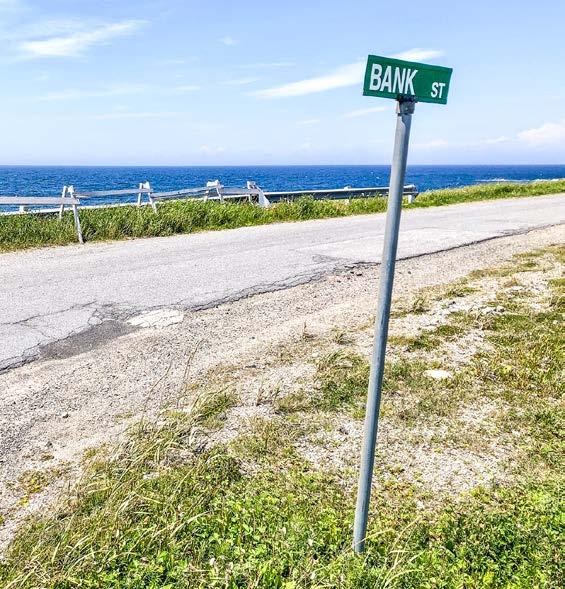
By John Crump
While there is some debate over how Ottawa’s Bank Street got its name, there is no doubt about the origin of a road of the same name in Daniel’s Harbour, Newfoundland. The village of 220 lies on the western shore of the Great Northern Peninsula and is in the riding of Premier Andrew Furey. Facing the cold waters of the Gulf of St. Lawrence, the wind blasts onto the shore, driving white-capped rollers onto the rocky beach that lies about 15 metres down a steep slope below Bank Street.
There are no grocery stores, ice cream parlours or coffee shops on this Bank Street. No pubs, hair salons or anything except a few wind-blasted houses. But what it lacks in amenities, it more than makes up for in ambiance. The next time I’m walking face to the wind on Ottawa’s Bank Street, I’ll remember the feeling of the cool wind off the gulf and the salty smell of the rocky bank below.
John Crump is a recently retired Glebe resident and president of the Glebe Community Association.
By Sue Reive

Neck pain is very common, affecting many people both young and old. Whether the pain arises from an acute muscle strain or results from a chronic degenerative neck condition the pain can interfere with normal daily activities like lifting, reading, and sleeping. Thankfully most neck pain can be resolved with specific exercises. Physical therapy can be beneficial in the rehabilitation of neck problems.
Many structures in the neck can cause pain when injured. The neck, also known as the cervical spine, is comprised of seven vertebrae which sit on top of each other. Except for the top two, the vertebral bodies are separated in front by a disc. They are joined together at the back by two facet joints. The circular spinal canal, housing the spinal cord, runs down behind the vertebral bodies. Nerves traverse through a small hole at each vertebral level. The spine is held together by ligaments, the disc and the surrounding muscles.
The cervical muscles attach the vertebrae together and can run up to the skull and down into the thoracic spine and shoulder blade.
Neck pain can be classified as acute (lasting less than three months) or chronic (lasting more than three months). The most common cause of acute neck pain is a muscle strain or ligament sprain. A fall carrying a heavy backpack or physical exertion can strain the muscles. Chronic neck pain is usually a result of a sprain of the facet joints or disc. The facet joints can get sprained with poor posture. The classic “crick in the neck” results when people wake up feeling locked, having
slept on their stomach, and can’t turn their head one way. When the facet joint gets overly compressed or, conversely, over stretched, the capsule will respond with pain and inflammation. Moreover, aging causes degenerative changes in the facet joint just like in a knee joint, making it more vulnerable to increased stress and strain.
Disc problems arise often when there is excessive load on the disc, often from repetitive heavy lifting or a torsional strain. The disc fiber tears and inflammation results. Sometimes the adjacent nerve root can get inflamed and compressed, causing radiating pain or possibly tingling down the arm.
Treatment is directed at restoring full mobility, reducing pain, improving strength and correcting poor postural habits. With mechanical neck pain, there will be movements that increase the pain but thankfully there will also be movements that reduce the pain. Exercise is a big component of the treatment. Acute muscle strains demand an effort to regain flexibility and strength. Chronic disc issues will usually respond to exercises which promote good cervical alignment such as neck retraction. Maintaining good posture places less stress on the spine. Keeping active is a good idea as prolonged positions, especially sitting, really aggravate the neck.
If you are experiencing neck pain, whether it is acute or chronic, physiotherapy can help teach you what to do and what not to do.
Sue Reive is a physiotherapist at Ottawa Physiotherapy and Sport Clinics Glebe.
By Marjolein Groenevelt
Lateral epicondylopathy is the accurate term for an injury to the tendons of the common extensor origin, on the outside of the elbow. These tendons lift the wrist and hand, are involved in gripping and turn the palm up, like when using a screwdriver. This injury got its colloquial name tennis elbow since it occurred in tennis players using a single-handed backhand.
Medial epicondylopathy is known as golfer’s elbow and is on the inside of the elbow. This is at the common flexor origin of the tendons that bend the wrist and fingers, turn the palm down and are used in gripping and lift ing. Both injuries are usually caused by repetitive overuse or strain but can also occur from a single injury, such as lift ing something very heavy.
activities other than tennis and golf,
so they are year–round issues. Anyone doing repetitive motions, especially with gripping, can develop either one. In the spring, onset can be due to gardening activities, such as turning soil, digging, weeding or trimming branches and hedges with clippers. Summer risks, as well as tennis and golf, include throwing sports, like baseball, and paddle sports, like kayaking, canoeing and standup paddle-boarding. Gardening is a risk again in the autumn, especially raking leaves. Winter brings on snow shovelling –
prolonged tension on the muscles, and the scrolling itself can be problematic if holding the fingers in constant “on” or tense position.
As with all injuries, it is important to think about what might have caused the injury. When and how did it occur? Was it a gradual or sudden onset? Being a detective will go a long way towards planning recovery.
Tendons are slow to heal, primarily because they do not get a lot of blood supply. If a tendon injury has become chronic, it will require a good assessment and treatment plan to ensure improvement. Figuring out what caused the injury is crucial, since what not to do can be as important as
rest alone does not heal tendons – if you put your elbow in a cast for three months, it would come out weak, but the tendon injury would still be there, and pain would return as soon as you resumed your previous activities. Light loading or strengthening activities are therefore added as soon as possible, and symptoms are monitored to avoid significant flare-ups.
Ice and anti-inflammatory medications, either oral or topical, are not recommended in the chronic phase, unless they are really needed for pain due to increased new inflammation. Improved blood flow is recommended, so doing whole body activities that warm up the area and using heat may help.
A period of relative rest, or decreased load, is first recommended, and how long depends on how inflamed theduced as soon as possible, because







What is also very important to all tendon injuries of the upper body, be it shoulder, elbow or wrist, is your posture – that is, the position of your spine, neck and shoulder girdle. It has been well-demonstrated that tension in the neck muscles or a pinched nerve will contribute to this problem. As well, analyzing whole body movement is important. Are you reaching too far with the rake or roller? Are you fatigued in your sport and not using your core and big muscles? Shortening the lever arm and using good body mechanics will lessen the load on the elbow. How can you keep up activities you love, such as sports or gardening? Many people find a brace helpful for more intense activities, including carrying grocery bags and chopping.
There are many factors to consider in a chronic tendon injury. A physiotherapist can help you with these and other questions.
Marjolein Groenevelt is a sports and vestibular physiotherapist who has lived in the Glebe since 1988. She established Glebe Physiotherapy and Sport Medicine in Fifth Avenue Court in 1994 and is now located at 106200 Marché Way and 30 Third Avenue. She can be reached at Marjolein.
By Jodi Ashton
A power outage couldn’t dampen the spirits of Jeannie Wong’s Grade 2/3 class as they took the Sirius XM stage with artists T.J. Wheeler, Lucas Haneman and Megan Laurence at Ottawa Bluesfest on Sunday, July 14. Despite the unexpected delay, these young performers remained patient and delivered an outstanding performance that captivated the audience of parents, families, friends and concert goers.
This year marked Wong’s impressive 25th consecutive year participating in the Blues in the Schools program. Her dedication to fostering a love of music in her students is evident in







their confidence and talent. The entire Corpus Christi school community is incredibly proud of their accomplishments, and we extend our heartfelt congratulations to Ms. Wong and her class for this memorable experience. Thank you to Ottawa Bluesfest and the Blues in the Schools Program for this incredible opportunity. We’re already looking forward to next year!
Jodi Ashton is principal of Corpus Christi Catholic School.
Dr. Nili Kaplan-Myrth
9
OCDSB Trustee, Zone
Trustee’s report
As I write this, it is early August. On the one hand, there’s one more month of the carefree laughter of children and youth in summertime. On the other hand, it’s time to cast our minds to September and preparations for kindergarten, middle school, high school, college or university. In many households, this time is met with a mixture of curiosity and fear, eagerness to reunite with friends, back-to-school anxiety about classes, uncertainty about what lies ahead. Over two decades, as a mother, I have experienced this mixture of excitement and apprehension as our three children have moved through their respective school years.
Our work at the Ottawa-Carleton District School Board will ramp up again in late August. It will be my third year as your trustee for Zone 9, representing Capital and Alta Vista, also a blend of excitement and foreboding. I will continue to sit on the Special Education Advisory Committee and will put up my hand, again, for the Advisory Committee on Equity.
There are timelines and work plans for specific projects ahead of us –analysis of the preliminary report on the Elementary Program Review (EPR), further public consultations, decisions about the EPR as well as the review of other policies – but we do not know
what we will encounter along the way, individually or as a group, nor do we know the outcome. The 2023-2027 Strategic Plan focuses on learning, well-being and social responsibility, and in it we commit to equity and inclusivity. How do we ensure that all students have safe, supportive, stimulating environments in which to thrive? How do we address ongoing socioeconomic, linguistic, geographic and other disparities? How do we respond to bullying and systemic discrimination? How do we adequately support students with disabilities and exceptionalities, 2SLGBTQ students, Black, Indigenous, Jewish, Muslim, Asian, South Asian and other students?
The reason I persist in this role, despite the countless hours, complex bureaucracy, dubious politics and personal risk, is the certainty that every child has a right to thrive in public education and the conviction that a focus on numeracy and literacy is not enough – JK to 12 is an opportunity for children to grow into critically thinking, engaged, informed, empathetic citizens.
On that note, cautiously, carefully, caringly onward.
Dr Nili Kaplan-Myrth, MD, CCFP, FCFP, PhD, is the school trustee for Zone 9, Ottawa-Carleton District School Board.


We’re all in, so she can stand out.
Elmwood is more than just a school, because she’s more than just a student.
To them, we’re a support system, a studio, a playground, a blank canvas. Here, they can explore beyond the curriculum, developing passions and skills that help them achieve whatever they can imagine.
Extensive co-curricular +sports program
International Baccalaureate World School, Pre-K to Grade 12
Robust financial aid program
Healthy meals prepared onsite
Transportation and before +after care available
Limited spaces in select grades available for September 2024. Visit us online to learn more about what's possible.
An independent day school for girls from Pre-Kindergarten to Grade 12


This space is a free community bulletin board for Glebe residents Send your GRAPEVINE message and your name, email address,
Messages without complete information will not be accepted. FOR SALE items must be less than $1,000.
ABBOTSFORD SENIOR CENTRE (950 Bank St ) BOOK SALE, Mon -Fri , 8:30 a m to 4:30 p m Pocketbook: $1 00, paperback: $2 00, hard cover: $3 00 or until Aug 30, fill a $10 00 bag, available at reception, with as many books as it will hold
ABBOTSFORD SENIOR CENTRE (950 Bank St ) FALL PROGRAM is now available Pick up your paper copy at Abbotsford, Mon -Fri , 8:30 a m to 4:30 p m or go to www glebecentre ca under Abbotsford Senior Centre and What’s up at Abbotsford Registration in-person or by telephone (613-230-5730) with Visa or Mastercard and also on-line with your own member keytag
Save the date: ABBOTSFORD SENIORS CENTRE presents A FUNDRAISING CONCERT, COCKTAIL PARTY & SILENT AUCTION The Womensong Collective: celebrating local women songwriter and supporting community Fri , Sept 20, 3:30-6 p m Cost: $30 (includes entertainment and refreshments) Buy your tickets by phone 613-230-5730 starting Tues , Aug 20 at 9 a m
ABBOTSFORD SENIOR CENTRE (950 Bank St )
LUNCH in the dining room on Tues & Thurs at noon Members and guests can buy a sandwich, soup, fruit and dessert, cafeteria style, first come, first served Pay at serving counter with cash or at reception with credit/debit card
ABBOTSFORD SENIORS CENTRE ONE-DAY INTERACTIVE WORKSHOP: I’m Retired! (now what?) A Workshop of Discovery for the Newly, or Nearly, Retired Join us for the day on Wed Oct 16 There will be short presentations from experts and those who have “taken the plunge” before! There will be time for small discussion groups, resources to be shared and body breaks The workshop will run from 9 a m -3 p m with lunch included The price of the workshop & lunch is $40 For more information or to register, go to the Centre’s Fall Program Guide, call 613-230-5730 or email abbotsford@glebecentre ca
ALPHA EXPERIENCE Come and explore the big questions of life, meaning and faith through the Alpha Film Series, Mondays, starting Sept 16, 7-9 p m at St Mary’s Parish, 100 Young St , access via parking lot For more details and to register, please go to https://tinyurl com/stmarysalpha Email: alpha@ stmarysottawa ca Alpha is free, the experience os priceless! Refreshments will be served Here is a three-minute video sharing what Alpha is about: youtu be/fViYK_Xb3Wg
CANTERBURY TREBLES Women’s Ensemble are holding AUDITIONS for our 2024-2025 season in early September! Rehearsing and performing in the heart of the Glebe, the Canterbury Trebles Women’s Ensemble is a welcoming and accepting ensemble, aspiring to bring music for women’s voices to the Ottawa region and beyond The choir has an eclectic repertoire and often partner with local charities to raise funds We are looking for singers for all sections of the ensemble In general, rehearsals take place every second Wednesday evening (6:30 to 9 p m ) at Glebe St James United Church (650 Lyon Street South) Auditions will take place on Wed, Sept 4 (starting at 6 p m ) and Sat, Sept 7 (starting at 9 a m ) If you are interested in auditioning for the choir, please contact canterburytrebles@ gmail com Audition information can be found on our website at canterburytrebles com
The CENTRAL EXPERIMENTAL FARM is holding a RESEARCH OPEN HOUSE AND BUG DAY (gardeningcalendar ca/event/research-open-houseand-bug-day-at-the-ottawa-central-experimental-farm/) Interested in learning more about the research that is happening at the Central Experimental Farm? Everyone’s invited to the Research Open House and Bug Day, on Sept 7 from 9 a m -4 p m Meet with scientists and learn about the research they are doing here on the CEF and across Canada Alongside research demonstrations and interactive activities, expert entomologists will be hosting Bug Day and sharing their love and knowledge of insects This free all-ages event is sure to have something for everyone in the family!
YOGA at the CENTRAL EXPERIMENTAL FARM Sun , Aug 18, at 10 a m Our first Yoga event on July 21 was a great success! South of the Ornamental Gardens is a serene spot surrounded by trees and close to the Organic Garden Watch for registration to open on the website www friendsofthefarm ca Hope to see you there!
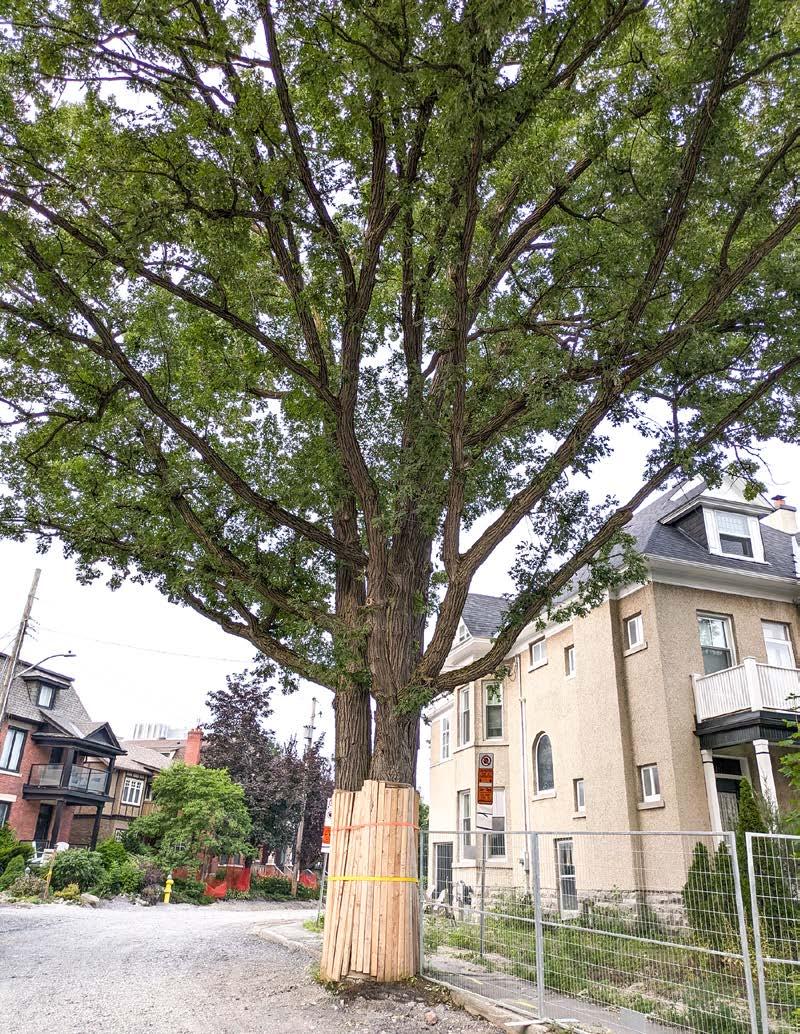
CONNECTING STREAMS announces a SCRIPTURE
MARATHON, a three-day public reading of the New Testament, Aug 16-18 This inspiring event aims to raise money for the Connect Centre, a newly opened drop-in centre and Christian resource room serving the Ottawa community The Scripture Marathon invites community members to participate in reading the entire New Testament aloud, creating a continuous, collective voice of faith and unity The event will be held at 816 Bank Street, in the courtyard of the Connect Centre, over 20 hours
PATHWAY YOGA is hosting a Fall Open House on Sat , Oct 5 from 1 to 4 p m We will start with a vigorous class from 1 to 2 p m followed by a tea social At 2:30 there will be a 1-hour beginner class for students new to Iyengar Yoga or looking to build from the foundation A tea social will follow We are located at 253 Echo Dr , in the Church of the Ascension We invite you to check the details of the Open House event on our website pathwayyoga ca
FOR SALE
MAHOGANY ANTIQUE DINING ROOM TABLE Duncan Phyfe incl leaf Measures 72” x 42”, 29” high $925 00 Call 613-261-4504
NORCO MULTI-SPEED BICYCLE LIKE NEW Model LRT Rilex RY Original cost $1,600 Comes with bicycle manual Sell for $650 00 Call 613-2614504
3 OAK WHISKY BARREL PLANTERS Brand new, never used, secured steel rings Size 27” wide x 18” high $185 00 Perfect for planting cedars or vegetables Call 613-261-4504
WANTED
Need a bit of extra cash? Looking for A FEMALE TO HELP 3-5 HOURS A WEEK with carrying laundry baskets, emptying the dishwasher and other easy tasks I am located near Holmwood and Percy Pay to be determined Please email janemh7620@gmail com
FRIENDS OF THE FARM (Central Experimental Farm) are in need of BOARDROOM FURNITURE We are seeking a boardroom table and chairs for 14 people If you have any ideas about where we might find such furniture for donation to the Friends, please let us know by writing to info@friendsofthefarm ca




Local Service in Ottawa since 1988 with Quality Flags, Banners, and Flagpoles. •

Home renos and repair — interior/ exterior painting; all types of flooring; drywall repair and installation; plumbing repairs and much more. Please call Jamie Nininger @ 613 852-8511.
RUSSELL ADAMS PLUMBER
613-978-5682

In the Glebe since 1988 with Quality Flags, Banners, Friendship Pins, Flag Repair and more.
838 Bank Street (613) 789-5456 www.flagshop.com
Bruyère Research Institute TIME at Home Study is looking for adults with balance and/or mobility problems, able to walk 10 metres, to participate in a free online exercise program designed by clinicians and delivered by the City of Ottawa. The program will run for 8 weeks, 2 classes per week. Contact us now for eligibility screening: amemarian@bruyere.org or (613) 562-6262 ext. 1419.

























